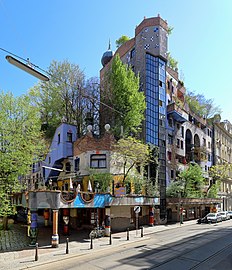Art Nouveau
Abbesses by Hector Guimard (1900); cover of Jugend magazine by Otto Eckmann (1896); wall cabinet by Louis Majorelle; interior of the Hôtel Tassel in Brussels by Victor Horta (1892–1893); lamp by Louis Comfort Tiffany (1900–1910) | |
| Years active | c. 1883–1914 |
|---|---|
| Location | Western world |
Art Nouveau (
One major objective of Art Nouveau was to break down the traditional distinction between fine arts (especially painting and sculpture) and applied arts. It was most widely used in interior design, graphic arts, furniture, glass art, textiles, ceramics, jewellery and metal work. The style responded to leading 19-century theoreticians, such as French architect
The first Art Nouveau houses and interior decoration
From Britain, Belgium and France, Art Nouveau spread to the rest of Europe, taking on different names and characteristics in each country (see Naming section below). It often appeared not only in capitals, but also in rapidly growing cities that wanted to establish artistic identities (Turin and Palermo in Italy; Glasgow in Scotland; Munich and Darmstadt in Germany; Barcelona in Catalonia, Spain), as well as in centres of independence movements (Helsinki in Finland, then part of the Russian Empire).
By 1914, with the beginning of the
Naming
The term Art Nouveau was first used in the 1880s in the Belgian journal
Art Nouveau is known by different names in different languages:
- In Austria and the neighbouring countries then part of the Austro-Hungarian Empire, it was called Wiener Jugendstil ('Viennese youth style'), or Secessionsstil ('Secession style'), after the artists of the Vienna Secession (Hungarian: szecesszió, Czech: secese, Slovak: secesia, Polish: secesja).
- In Belgium, it was sometimes termed Style coup de fouet ('Whiplash style'), Paling Stijl ('Eel Style'), or Style nouille ('Noodle style') by its detractors.[10]
- In Britain, besides Art Nouveau, it was known as the Modern Style, or, because of the works of the Glasgow School, as the Glasgow style.
- In Denmark, it is known as Skønvirke ('Work of beauty').
- In Germany and Scandinavia, it was called Reformstil ('Reform style'), or Jugendstil ('Youth style'), after the popular German art magazine Jugend,[10] as well as Wellenstil ('Wave style'), or Lilienstil ('Lily style').[9] It is now called Jugend in Finland, Sweden, and Norway; Juugend in Estonia; and Jūgendstils in Latvia. In Finland, it was also called Kalevala Style.
- In Italy, it was often called stile Liberty ('Liberty style'), after Arthur Lasenby Liberty, the founder of London's Liberty & Co, whose textile designs were popular. It was also sometimes called stile floreale ('floral style') or arte nuova ('new art'; not in use anymore).[10]
- In Japan, Shiro-Uma.[11]
- In the Netherlands, Nieuwe Kunst ('New Art'), or Nieuwe Stijl ('New style').[12][9]
- In Portugal, Arte nova ('New Art').
- In Romania, Arta 1900 ('1900 Art'), Arta Nouă ('New Art'), or Noul Stil ('New Style').[13]
- In Spain, Modernismo, Modernisme (in Catalan) and Arte joven ('Young art').
- In Switzerland, style sapin ('fir-tree style').[9]
- In the United States, due to its association with Louis Comfort Tiffany, it was sometimes called the Tiffany style.[2][12][9][14]
- The term Modern was used in then Mir Iskusstva('World of Art') movement was also used.
History
Origins
-
Japanese woodblock print byUtagawa Kunisada(1850s)
-
The Peacock Room by James McNeill Whistler (1876–77), now in the Freer Gallery of Art, Washington, D.C.
-
Chair designed byArthur Mackmurdo(1882–83)
-
William Morris printed textile design (1883)
-
Swan, rush and iris wallpaper design by Walter Crane (1883)
The new art movement had its roots in Britain, in the floral designs of
In France, it was influenced by the architectural theorist and historian Eugène Viollet-le-Duc, a declared enemy of the historical Beaux-Arts architectural style, whose theories on rationalism were derived from his study of medieval art:
- Function should define form.[17]
- Unity of the arts and the abolition of any distinction between major art (architecture) and minor arts (decorative arts).[18]
- Nature's logic is the model to be used for architecture.[19]
- Architecture should adapt itself to man's environment and needs.
- Use of modern technologies and materials.[20]
Viollet-le-Duc was himself a precursor of Art Nouveau: in 1851, at Notre-Dame de Paris, he created a series of mural paintings typical of the style.[21] These paintings were removed in 1945 as deemed non academic. At the Château de Roquetaillade in the Bordeaux region, his interior decorations dating from 1865 also anticipate Art Nouveau. In his 1872 book Entretiens sur l'architecture, he wrote, "Use the means and knowledge given to us by our times, without the intervening traditions which are no longer viable today, and in that way we can inaugurate a new architecture. For each function its material; for each material its form and its ornament."[22] This book influenced a generation of architects, including Louis Sullivan, Victor Horta, Hector Guimard, and Antoni Gaudí.[23]
The French painters Maurice Denis, Pierre Bonnard and Édouard Vuillard played an important part in integrating fine arts painting with decoration. "I believe that before everything a painting must decorate", Denis wrote in 1891. "The choice of subjects or scenes is nothing. It is by the value of tones, the coloured surface and the harmony of lines that I can reach the spirit and wake up the emotions."[24] These painters all did both traditional painting and decorative painting on screens, in glass, and in other media.[25]
Another important influence on the new style was
New technologies in printing and publishing allowed Art Nouveau to quickly reach a global audience. Art magazines, illustrated with photographs and colour
Development – Brussels (1893–1898)
-
Hankar House by Paul Hankar (1893)
-
Façade of the Hôtel Tassel by Victor Horta (1892–93)
-
Stairway of the Hôtel Tassel
-
Villa Bloemenwerf by Henry van de Velde (1895)
-
Chair by Van de Velde for the Villa Bloemenwerf (1895)
-
Poster for thePrivat Livemont(1897)
The first Art Nouveau town houses, the Hankar House by Paul Hankar (1893) and the Hôtel Tassel by Victor Horta (1892–1893),[4][5] were built almost simultaneously in Brussels. They were similar in their originality, but very different in their design and appearance.
Victor Horta was among the most influential architects of early Art Nouveau, and his Hôtel Tassel (1892–1893) in Brussels is one of the style's landmarks.
Paul Hankar was also an innovator of early Art Nouveau. Born at
The debut of Art Nouveau architecture in Brussels was accompanied by a wave of Decorative Art in the new style. Important artists included Gustave Strauven, who used wrought iron to achieve baroque effects on Brussels façades; the furniture designer Gustave Serrurier-Bovy, known for his highly original chairs and articulated metal furniture; and the jewellery designer Philippe Wolfers, who made jewellery in the form of dragonflies, butterflies, swans and serpents.[42]
The Brussels International Exposition held in 1897 brought international attention to the style; Horta, Hankar, Van de Velde, and Serrurier-Bovy, among others, took part in the design of the fair, and Henri Privat-Livemont created the poster for the exhibition.
Paris – Maison de l'Art Nouveau (1895) and Castel Beranger (1895–1898)
-
Siegfried Bing invited artists to show modern works in his new Maison de l'Art Nouveau (1895).
-
The Maison de l'Art Nouveau gallery of Siegfried Bing (1895)
-
Poster by Félix Vallotton for the new Maison de l'Art Nouveau (1896)
-
Gateway of the Castel Béranger by Hector Guimard (1895–1898)
-
Breezeway of the Castel Béranger, with wall plates by Alexandre Bigot
-
Detail of main stairway of the Castel Béranger
The Franco-German art dealer and publisher
The style was quickly noticed in neighbouring France. After visiting Horta's Hôtel Tassel, Hector Guimard built the Castel Béranger, among the first Paris buildings in the new style, between 1895 and 1898.[nb 1] Parisians had been complaining of the monotony of the architecture of the boulevards built under Napoleon III by Georges-Eugène Haussmann. The Castel Beranger was a curious blend of Neo-Gothic and Art Nouveau, with curving whiplash lines and natural forms. Guimard, a skilled publicist for his work, declared: "What must be avoided at all cost is...the parallel and symmetry. Nature is the greatest builder of all, and nature makes nothing that is parallel and nothing that is symmetric."[45]
Parisians welcomed Guimard's original and picturesque style; the Castel Béranger was chosen as one of the best new façades in Paris, launching Guimard's career. Guimard was given the commission to design the entrances for the new Paris Métro system, which brought the style to the attention of the millions of visitors to the city's 1900 Exposition Universelle.[10]
Paris Exposition Universelle (1900)
-
Main entrance to the Paris 1900 Exposition Universelle
-
The Bigot Pavilion, showcasing the work of ceramics artist Alexandre Bigot
-
Entrance to the Austrian Pavilion, with exhibits designed by Josef Hoffmann
-
The German Pavilion, designed by Bruno Möhring
-
Paris metro station entrance atPorte Dauphine designed by Hector Guimard
-
The Finnish Pavilion, designed by Armas Lindgren and Eliel Saarinen
-
Menu designed by Alphonse Mucha for the restaurant of the Bosnian Pavilion
-
Portico of theSevres PorcelainPavilion, now on Square Félix-Desruelles
The Paris 1900 Exposition universelle marked the high point of Art Nouveau. Between April and November 1900, it attracted nearly fifty million visitors from around the world, and showcased the architecture, design, glassware, furniture and decorative objects of the style. The architecture of the Exposition was often a mixture of Art Nouveau and Beaux-Arts architecture: the main exhibit hall, the Grand Palais had a Beaux-Arts façade completely unrelated to the spectacular Art Nouveau stairway and exhibit hall in the interior.
French designers all made special works for the Exhibition: Lalique crystal and jewellery; jewellery by Henri Vever and Georges Fouquet; Daum glass; the Manufacture nationale de Sèvres in porcelain; ceramics by Alexandre Bigot; sculpted glass lamps and vases by Émile Gallé; furniture by Édouard Colonna and Louis Majorelle; and many other prominent arts and crafts firms. At the 1900 Paris Exposition, Siegfried Bing presented a pavilion called Art Nouveau Bing, which featured six different interiors entirely decorated in the Style.[46][47]
The Exposition was the first international showcase for Art Nouveau designers and artists from across Europe and beyond. Prize winners and participants included
While the Paris Exposition was by far the largest, other expositions did much to popularize the style. The
Local variations
Art Nouveau in France
-
Doorway of the Lavirotte Building, with ceramic sculptures by Jean-Baptiste Larrivé
-
Jewellery shop ofCarnavalet Museum(1901)
-
Villa Majorelle in Nancy for furniture designer Louis Majorelle by architect Henri Sauvage (1901–02)
-
Alfred Wagon building at 24, place Étienne Pernet, Paris (1905)
-
Rouen-Rive-Droite railway station by Adolphe Dervaux, with sculptures by Camille Lefèvre(1928)
Following the 1900 Exposition, the capital of Art Nouveau was Paris. The most extravagant residences in the style were built by Jules Lavirotte, who entirely covered the façades with ceramic sculptural decoration. The most flamboyant example is the Lavirotte Building, at 29, avenue Rapp (1901). Office buildings and department stores featured high courtyards covered with stained glass cupolas and ceramic decoration. The style was particularly popular in restaurants and cafés, including Maxim's at 3, rue Royale, and Le Train bleu at the Gare de Lyon (1900).[53]
The status of Paris attracted foreign artists to the city. The Swiss-born artist
The city of Nancy in Lorraine became the other French capital of the new style. In 1901, the Alliance provinciale des industries d'art, also known as the École de Nancy, was founded, dedicated to upsetting the hierarchy that put painting and sculpture above the decorative arts. The major artists working there included the glass vase and lamp creators Émile Gallé, the Daum brothers in glass design, and the designer Louis Majorelle, who created furniture with graceful floral and vegetal forms. The architect Henri Sauvage brought the new architectural style to Nancy with his Villa Majorelle in 1902.
-
Tea set by Bapst & Falize, Germain Bapst, and Lucien Falize, made of partially gilt silver, ivory and agate (c. 1889)
-
Poster for the dancer Loie Fuller by Jules Chéret (1893)
-
Poster by Camille Martin for L'Exposition d'art décoratif at the Galeries Poirel in Nancy (1894)
-
Doors with stained glass for the Store of Francois Vaexlaire in Nancy (1901), glass by Jacques Grüber, doors by Émile Andrè and Eugéne Vallin
-
Bedroom furniture of the Villa Majorelle (1901–02), now in the Museum of Fine Arts of Nancy
The French style was widely propagated by new magazines, including The Studio, Arts et Idées and Art et Décoration, whose photographs and colour
In France, the style reached its summit in 1900, and thereafter slipped rapidly out of fashion, virtually disappearing from France by 1905. Art Nouveau was a luxury style, which required expert and highly-paid craftsmen, and could not be easily or cheaply mass-produced. One of the few Art Nouveau products that could be mass-produced was the perfume bottle, and these are still manufactured in the style today.
Art Nouveau in Belgium
-
Hôtel van Eetvelde in Brussels by Victor Horta (1895–1901)
-
Detail of the Winter Garden of the Hôtel van Eetvelde
-
Chair by Henry van de Velde (1896)
-
Philippe Wolfers, Plumes de Paon ('Peacock Feathers'), belt buckle (1898)
-
Bed and mirror by Gustave Serrurier-Bovy (1898–99), now in the Musée d'Orsay, Paris
-
Saint-Cyr House in Brussels by Gustave Strauven (1901–1903)
Belgium was an early centre of Art Nouveau, thanks largely to the architecture of Victor Horta, who designed one of the first Art Nouveau houses, the Hôtel Tassel in 1893, and three other townhouses in variations of the same style. They are now UNESCO World Heritage sites. Horta had a strong influence on the work of the young Hector Guimard, who came to see the Hôtel Tassel under construction, and later declared that Horta was the "inventor" of the Art Nouveau.[56] Horta's innovation was not the façade, but the interior, using an abundance of iron and glass to open up space and flood the rooms with light, and decorating them with wrought iron columns and railings in curving vegetal forms, which were echoed on the floors and walls, as well as the furniture and carpets which Horta designed.[57]
Gustave Strauven began his career as an assistant designer working with Horta, before he started his own practice at age 21, making some of the most extravagant Art Nouveau buildings in Brussels. His most famous work is the Saint-Cyr House at 11, square Ambiorix/Ambiorixsquare. The house is only 4 metres (13 ft) wide, but is given extraordinary height by his elaborate architectural inventions. It is entirely covered by polychrome bricks and a network of curling vegetal forms in wrought iron, in a virtually Art Nouveau-Baroque style.[59]
Other important Art Nouveau artists from Belgium included the architect and designer Henry van de Velde, though the most important part of his career was spent in Germany; he strongly influenced the decoration of the Jugendstil. Others included the decorator Gustave Serrurier-Bovy, and the graphic artist Fernand Khnopff.[5][60][61] Belgian designers took advantage of an abundant supply of ivory imported from the Belgian Congo; mixed sculptures, combining stone, metal and ivory, by such artists as Philippe Wolfers, was popular.[62]
Nieuwe Kunst in the Netherlands
-
Poster for Delft Salad Oil by Jan Toorop (1893)
-
Amsterdam Commodities Exchange byHendrik Petrus Berlage(1896–1903)
-
Cabinet/Desk by Berlage (1898)
-
Vase with abstract floral design by Theo Colenbrander (1898)
-
Porcelain vase designed by J. Jurriaan Kok and decorated by W.R. Sterken (1901)
In the Netherlands, the style was known as the Nieuwe Stijl ('New Style'), or Nieuwe Kunst ('New Art'), and it took a different direction from the more floral and curving style in Belgium. It was influenced by the more geometric and stylized forms of the German Jugendstil and Austrian Vienna Secession.[62] It was also influenced by the art and imported woods from Indonesia, then the Dutch East Indies, particularly the designs of the textiles and batik from Java.
The most important architect and furniture designer in the style was
Other buildings in the style include the
Prominent graphic artists and illustrators in the style included Jan Toorop, whose work inclined toward mysticism and symbolism, even in his posters for salad oil. In their colors and designs, they also sometimes showed the influence of the art of Java.[64]
Important figures in Dutch ceramics and porcelain included Jurriaan Kok and Theo Colenbrander. They used colorful floral pattern and more traditional Art Nouveau motifs, combined with unusual forms of pottery and contrasting dark and light colors, borrowed from the batik decoration of Java.[65]
Modern Style and Glasgow School in Britain
-
Cover design byArthur Mackmurdo for a book on Christopher Wren(1883)
-
Belt buckle by Archibald Knox for Liberty department store (1899)
-
Pub building by James Hoey Craigie at 59 Dumbarton Road, Glasgow (1899–1900)
-
Hatrack building by James Salmon at 142a, 144 St. Vincent Street, Glasgow (1899–1902)
-
The May Queen by Margaret Macdonald Mackintosh (1900)[66]
-
Interior hallway view, Hill House, Helensburgh, Scotland, designed and built by Walter Blackie (1902–1904)[67]
Art Nouveau had its roots in Britain, in the
Other important innovators in Britain included the graphic designers Aubrey Beardsley whose drawings featured the curved lines that became the most recognizable feature of the style. Free-flowing wrought iron from the 1880s could also be adduced, or some flat floral textile designs, most of which owed some impetus to patterns of 19th century design. Other British graphic artists who had an important place in the style included Walter Crane and Charles Ashbee.[70]
The Liberty department store in London played an important role, through its colourful stylized floral designs for textiles, and the silver, pewter, and jewellery designs of Manxman (of Scottish descent) Archibald Knox. His jewellery designs in materials and forms broke away entirely from the historical traditions of jewellery design.
For Art Nouveau architecture and furniture design, the most important centre in Britain was
Jugendstil in Germany
-
Ernst Ludwig House inDarmstadt Artists' Colony by Joseph Maria Olbrich(1900), now hosting Darmstadt Colony Museum
-
Mexikoplatz station in Berlin by Gustav Hart and Alfred Lesser (1902–1904)
-
Spa complex Sprudelhof in Bad Nauheim (1905–1911)
-
Hackesche Höfe in Berlin by Endell (1906)
-
Wedding tower in Darmstadt Artists' Colony (1908)
-
Entrance door of Großes Haus Glückert in Darmstadt Artists' Colony
German Art Nouveau is commonly known by its German name,
In 1892 Georg Hirth chose the name Munich Secession for the Association of Visual Artists of Munich. The Vienna Secession, founded in 1897,[77] and the Berlin Secession also took their names from the Munich group.
The journals Jugend and
Otto Eckmann was one of the most prominent German artists associated with both Die Jugend and Pan. His favourite animal was the swan, and so great was his influence that the swan came to serve as the symbol of the entire movement. Another prominent designer in the style was Richard Riemerschmid, who made furniture, pottery, and other decorative objects in a sober, geometric style that pointed forward toward Art Deco.[78] The Swiss artist Hermann Obrist, living in Munich, illustrated the coup de fouet or whiplash motif, a highly stylized double curve suggesting motion taken from the stem of the cyclamen flower.
-
Cover of Pan magazine by Joseph Sattler (1895)
-
Cover of Jugend magazine by Otto Eckmann (1896)
-
Tapestry The Five Swans by Otto Eckmann (1896–97)
-
Poster of theFranz Stuck(1898–1900)
-
Jugendstil door handle in Berlin (c. 1900)
-
Chair by Richard Riemerschmid (1902)
-
Jugendstil dining room set and dishes by Peter Behrens (1900–01)
-
Stoneware jug by Richard Riemerschmid (1902)
-
Jugendstil pewter dish by WMF, design no. 232 (c. 1906)
The
Another notable union in German Empire was the Deutscher Werkbund, founded in 1907 in Munich at the instigation of Hermann Muthesius by artists of Darmstadt Colony Joseph Maria Olbrich, Peter Behrens; by another founder of Vienna Secession Josef Hoffmann, as well as by Wiener Werkstätte (founded by Hoffmann), by Richard Riemerschmid, Bruno Paul and other artists and companies.[81] Later Belgian Henry van de Velde joined the movement[nb 2]. The Grand-Ducal School of Arts and Crafts, founded by him in Weimar, was a predecessor of Bauhaus, one of the most influential currents in Modernist architecture.[83]
In Berlin, Jugendstil was chosen for the construction of several railway stations. The most notable[84] is Bülowstraße by Bruno Möhring (1900–1902), other examples are Mexikoplatz (1902–1904), Botanischer Garten (1908–1909), Frohnau (1908–1910), Wittenbergplatz (1911–1913) and Pankow (1912–1914) stations. Another notable structure of Berlin is Hackesche Höfe (1906) which used polychrome glazed brick for the courtyard façade.
Secession in Austria–Hungary
Vienna Secession
-
Secession Hall in Vienna by Joseph Maria Olbrich(1897–98)
-
Floral design by Alois Ludwig on the façade of Maiolica House in Vienna by Otto Wagner (1898)
-
Karlsplatz Stadtbahn Station in Vienna by Wagner (1899)
-
Church of St. Leopold in Vienna by Wagner (1903–1907)
-
Interior of the Church of St. Leopold, with altarpiece by Leopold Forstner
Vienna became the centre of a distinct variant of Art Nouveau, which became known as the Vienna Secession. The movement took its name from Munich Secession established in 1892. Vienna Secession was founded in April 1897 by a group of artists that included Gustav Klimt, Koloman Moser, Josef Hoffmann, Joseph Maria Olbrich, Max Kurzweil, Ernst Stöhr, and others.[77] The painter Klimt became the president of the group. They objected to the conservative orientation toward historicism expressed by Vienna Künstlerhaus, the official union of artists. The Secession founded a magazine, Ver Sacrum, to promote their works in all media.[85] The architect Joseph Olbrich designed the domed Secession building in the new style, which became a showcase for the paintings of Gustav Klimt and other Secession artists.
Klimt became the best-known of the Secession painters, often erasing the border between fine art painting and decorative painting. Koloman Moser was an extremely versatile artist in the style; his work including magazine illustrations, architecture, silverware, ceramics, porcelain, textiles, stained glass windows, and furniture.
-
Vampire in Ver Sacrum, no. 12, p. 8, by Ernst Stöhr (1899)
-
Woman in a Yellow Dress by Max Kurzweil (1899)
-
Vase byJohann Loetz Witwe(c. 1900)
-
Armchair by Koloman Moser (c. 1900)
-
Poster for the 14th Secession Exhibit, by Alfred Roller (1902)
-
The Kiss by Gustav Klimt (1907–08)
The most prominent architect of the Vienna Secession was Otto Wagner,[86] he joined the movement soon after its inception to follow his students Hoffmann and Olbrich. His major projects included several stations of the urban rail network (the Stadtbahn), the Linke Wienzeile Buildings (consisting of Majolica House, the House of Medallions and the house at Köstlergasse). The Karlsplatz Station is now an exhibition hall of the Vienna Museum. The Kirche am Steinhof of Steinhof Psychiatric hospital (1904–1907) is a unique and finely-crafted example of Secession religious architecture, with a traditional domed exterior but sleek, modern gold and white interior lit by abundance of modern stained glass.
In 1899
Hungarian Szecesszió
-
Geological Museum of Budapest by Lechner (1898–99)
-
Façade detail of Cifrapalota in Kecskemét (1902)
-
Mosaic on the façade of Török Bank building in Budapest by Miksa Róth (1906)
-
Relief on the façade of Gresham Palace in Budapest by Géza Maróti (1906)
-
Black Eagle Palace in Oradea, today in Romania, at that time part of the Austro-Hungarian Empire, by Marcell Komor and Dezső Jakab (1907–08)
-
Brück House in Timișoara, today in Romania (1911). Along with Oradea, Timișoara is part of the Art Nouveau European Route[91]
-
Gróf Palace in Szeged by Ferenc Raichle (1913)
The pioneer and prophet of the Szecesszió ('Secession' in Hungarian), the architect Ödön Lechner, created buildings which marked a transition from historicism to modernism for Hungarian architecture.[92] His idea for a Hungarian architectural style was the use of
Works by Ödön Lechner
Another important architect was
-
Pax, mosaic by Miksa Róth, which received the silver medal at the Paris World Exhibition in 1900
-
Cabinet by Ödön Faragó, from Budapest (1901)
-
Window with flower motives from the Villa Alpár in Budapest, by Miksa Róth (1903)
The movement that promoted Szecesszió in arts was Gödöllő Art Colony, founded by Aladár Körösfői-Kriesch, also a follower John Ruskin and William Morris and a professor at the Royal School of Applied Arts in Budapest in 1901.[95] Its artists took part in many projects, including the Franz Liszt Academy of Music in Budapest.[96]
An associate to Gödöllő Art Colony,[97] Miksa Róth was also involved in several dozen Szecesszió projects, including Budapest buildings including Gresham Palace (stained glass, 1906) and Török Bank (mosaics, 1906) and also created mosaics and stained glass for Palace of Culture (1911–1913) in Marosvásárhely.
A notable furniture designer is Ödön Faragó who combined traditional popular architecture, oriental architecture and international Art Nouveau in a highly picturesque style. Pál Horti, another Hungarian designer, had a much more sober and functional style, made of oak with delicate traceries of ebony and brass.
Secession in Bohemia, Moravia and Slovakia
-
Prague main railway station by Josef Fanta (1901–1909)
-
Cultural House in Skalica by Dušan Jurkovič (1905)
-
Municipal House in Prague by Osvald Polívkaand Antonín Balšánek (1905–1912)
-
Frescoes of Municipal House by Alphonse Mucha
-
Stained glass window of St. Vitus Cathedral in Prague by Mucha
-
Ceramic relief of Viola Theater in Prague by Ladislav Šaloun
-
New City Hall of Prague by Polívka (1908–1911)
The most notable Secession buildings in Prague are examples of
The most important Czech architect of this period was Jan Kotěra, who studied in Vienna under Otto Wagner. His best-known works are the Peterka House at 12 Wenceslas Square in Prague (1899–1900), the National House in Prostějov (1905–1907) and the Museum of Eastern Bohemia in Hradec Králové (1909–1912). Many important Vienesse architects were born in Moravia or Austrian Silesia, like Josef Hoffmann, Hubert Gessner, Joseph Maria Olbrich and Leopold Bauer.
The style of combining Hungarian Szecesszió and national architectural elements was typical for a Slovak architect Dušan Jurkovič. His most original works are the Cultural House in Szakolca (now Skalica in Slovakia, 1905), the buildings of spa in Luhačovice (now Czech Republic) in 1901–1903 and 35 war cemeteries near Nowy Żmigród in Galicia (now Poland), most of them heavily influenced by local Lemko (Rusyn) folk art and carpentry (1915–1917).
Secession in Galicia
-
Palace of Art in Kraków by Mączyński (1898–1901) – eastern façade
-
House Under the Globe in Kraków by Mączyński and Tadeusz Stryjeński (1904–05)
-
Interior of the House Under the Globe in Kraków by Józef Mehoffer
-
Lviv railway station by Władysław Sadłowski (1899–1904)
-
Frog House in Bielsko-Biała by Emanuel Rost (1903)
-
Saint Nicholas' Cathedral in Bielsko-Biała by Leopold Bauer (1909–10)
-
Vita somnium breve, stained glass by Mehoffer (1895), in the National Museum in Kraków
-
Apollo (System Copernicus), stained glass by Stanisław Wyspiański, House of the Medical Society in Kraków (1905)
-
Peacock. Portrait of Zofia Borucińska by Kazimierz Stabrowski (1908)
-
The Hutsul Madonna triptych by Kazimierz Sichulski (1909), in the Österreichische Galerie Belvedere, Vienna
-
"Iris" stained glass window, Kraków, Pollera Hotel, 30 Szpitalna Street (c. 1900)
The most important centres of Secession in
In Lviv the most important architect was Władysław Sadłowski, who studied in Vienna and was influenced by Otto Wagner. He designed the Lviv railway station (1899–1904), the Lviv's Philharmonic (1905–1908), and the Industrial School (1907–1908). Other important architected, also inspired by Wagner, was Ivan Levynskyi.
One of the most famous buildings in Bielsko-Biała is the so-called Frog House by Emanuel Rost (1903). Other important examples of Secession were designed by Vienesse architects: Max Fabiani, the author of the house at 1 Barlickiego Street (1900) as well as Leopold Bauer, who designed the house at 51 Stojałowskiego Street (1903) and the rebuilding of the Saint Nicholas' Cathedral (1909–10).
Secession in Slovenia, Bosnia, Croatia and Trieste
-
Grand Hotel Union in Ljubljana by Vancaš (1902–03)
-
Hauptmann Building in Ljubljana by Ciril Metod Koch (1904)
-
Bartoli House in Trieste by Max Fabiani (1906)
-
Central Post Office in Sarajevo by Vancaš (1907–1913)
-
Croatian State Archives in Zagreb by Rudolf Lubinski (1911–1913)
The most prolific Slovenian Secession architect was Ciril Metod Koch.[99] He studied at Otto Wagner's classes in Vienna and worked in the Laybach (now Ljubljana, Slovenia) City Council from 1894 to 1923. After the earthquake in Laybach in 1895, he designed many secular buildings in Secession style that he adopted from 1900 to 1910:[99] Pogačnik House (1901), Čuden Building (1901), The Farmers Loan Bank (1906–07), renovated Hauptmann Building in Secession style in 1904. The highlight of his career was the Loan Bank in Radmannsdorf (now Radovljica) in 1906.[99]
Other important Slovene architect, who was active also in Bosnia, was Josip Vancaš, the authot of such works like Grand Hotel Union (1902–1903) or City Savings Bank in Ljubljana (1902–1903) as well as the Ješua D. Salom Mansion (1901) and the Central Post Office in Sarajevo (1907–1913). Also Jože Plečnik and Max Fabiani, both important Vienna Secession architects, were born in Slovenia. The latter designed some buildings in Slovenia and Trieste, like the Bartoli House in Trieste (1906).
In Croatia, the most important examples of Secession include the Kallina House in Zagreb by Vjekoslav Bastl (1903–1904) and the Croatian State Archives in Zagreb by Rudolf Lubinski (1911–1913). </ref>
Arta 1900 or Art Nouveau in Romania
-
Minerva publisher headquarter on Bulevardul Regina Elisabeta in Bucharest, unknown architect (c. 1900, destroyed by WW2 bombardments)
-
Frieze of Strada Constantin F. Robescu no. 1 in Bucharest, unknown architect (c. 1900)
-
Door of Piața Mihail Kogălniceanu no. 7 in Bucharest, unknown architect (c. 1900)
-
Romulus Porescu House (Strada Doctor Paleologu no. 12) in Bucharest by Dimitrie Maimarolu (1905)[100]
-
Former Al. Assan shop (Strada Lipscani no. 72–74) in Bucharest, unknown architect (before 1906)[101]
-
Mița the Cyclist House in Bucharest by Nicolae C. Mihăescu (1908), mix of Beaux Arts and Art Nouveau[102]
Art Nouveau appears in Romania during the same years as it does in Western Europe (early 1890s until the outbreak of World War I in 1914), but here few are the buildings in this style, the
-
Young woman by Ștefan Luchian, drawing for the cover of Ileana magazine (1900)
-
Spring, decorative panel by Luchian (1901)
-
Woman with Lyre (Allegory of Music) by Nicolae Vermont (1903)
-
The Water Fairy by Elena Alexandrina Bednarik (1908)
-
Stove in the Mița the Cyclist House (Strada Biserica Amzei no. 9), Bucharest, possibly designed by Nicolae C. Mihăescu (1908)[102]
One of the most notable Art Nouveau painters from Romania was Ștefan Luchian, who quickly took over the innovative and decorative directions of Art Nouveau for a short period of time. The moment was synchronized with the founding of the Ileana Society in 1897, of which he was a founding member, a company that organized an exhibition (1898) at the Union Hotel entitled The Exhibition of Independent Artists and published a magazine – the Ileana Magazine.[104]
Transylvania has examples of both Art Nouveau and Romanian Revival buildings, the former being from the Austro-Hungarian era. Most of them can be found in Oradea, nicknamed the "Art Nouveau capital of Romania",[105] but also in Timișoara, Târgu Mureș and Sibiu.[106][107][108]
Stile Liberty in Italy
-
Villino Florio in Palermo by Ernesto Basile (1899–1902)
-
Poster for the 1902 Turin Exposition by Leonardo Bistolfi
-
Cobra chair and desk by Carlo Bugatti (1902), in the Brooklyn Museum, New York City
-
Entrance of Casa Guazzoni in Milan by Giovanni Battista Bossi (1904–1906)
Art Nouveau in Italy was known as arte nuova, stile floreale, stile moderno and especially stile Liberty. Liberty style took its name from Arthur Lasenby Liberty and the store he founded in 1874 in London, Liberty department store, which specialised in importing ornaments, textiles and art objects from Japan and the Far East, and whose colourful textiles which were particularly popular in Italy. Notable Italian designers in the style included Galileo Chini, whose ceramics were often inspired both by majolica patterns. He was later known as a painter and a theatrical scenery designer; he designed the sets for two celebrated Puccini operas Gianni Schicchi and Turandot.[109][110][12]
Liberty style architecture varied greatly, and often followed historical styles, particularly the Baroque. Façades were often drenched with decoration and sculpture. Examples of the Liberty style include the Villino Florio (1899–1902) by Ernesto Basile in Palermo; the Palazzo Castiglioni in Milan by Giuseppe Sommaruga (1901–1903); Milan, and the Casa Guazzoni (1904–05) in Milan by Giovanni Battista Bossi (1904–06).[111]
Colorful frescoes, painted or in ceramics, and sculpture, both in the interior and exterior, were a popular feature of Liberty style. They drew upon both classical and floral themes. as in the baths of Acque della Salute, and in the Casa Guazzoni in Milan.
The most important figure in Liberty style design was Carlo Bugatti, the son of an architect and decorator, father of Rembrandt Bugatti, Liberty sculptor, and of Ettore Bugatti, famous automobile designer. He studied at the Milanese Academy of Brera, and later the Académie des Beaux-Arts in Paris. His work was distinguished by its exoticism and eccentricity, included silverware, textiles, ceramics, and musical instruments, but he is best remembered for his innovative furniture designs, shown first in the 1888 Milan Fine Arts Fair. His furniture often featured a keyhole design, and had unusual coverings, including parchment and silk, and inlays of bone and ivory. It also sometimes had surprising organic shapes, copied after snails and cobras.[112]
Art Nouveau and Secession in Serbia
-
Pučka Bank in Pančevo by Albert Kálmán Kőrössy and Ullmann Gyula (1868)
-
Iodine Spa in Novi Sad (1897)
-
Subotica Synagogue by Marcell Komor and Dezső Jakab (1901)
-
Raichle Palace in Subotica (1904)
-
Karađorđević Bridge (previously named Franz Josef Bridge) in Zrenjanin (1904)
-
Novi Sad Synagogue by Lipót Baumhorn (1905)
-
Building of Merchant Stamenković in Belgrade by Nikola Nestorović and Andra Stevanović (1907)
-
Hotel Moskvain Belgrade by Jovan Ilkić (1908)
-
Menrat's Palace in Novi Sad by Lipót Baumhorn (1908)
-
Subotica City Hall by Dezső Jakab (1910)
-
Mika Alas's House in Belgrade by Petar Bajalović (1910)
Due to the close proximity to Austria–Hungary and Vojvodina being part of the empire until 1918, both the Vienna Secession and Hungarian Szecesszió were prevalent movements in what is today's northern Serbia, as well as the Capital of Belgrade.[113] Famous Austrian and Hungarian architects would design many buildings in Subotica, Novi Sad, Palić, Zrenjanin, Vrbas, Senta, and Kikinda. Art Nouveau heritage in Belgrade, Pančevo, Aranđelovac, and Vrnjačka Banja are a mixture of French, German, Austrian, Hungarian, and local Serbian movements. From the curvy floral beauty of the Subotica's Synagogue to the Morava-style inspired rosettes on Belgrade's telegraph building, Art Nouveau architecture takes various shapes in present-day Serbia.
Back in early 1900s, north of the Sava and the Danube, resurgent Hungarian national sentiment infused the buildings in Subotica and Senta with local floral ethnic motifs, while in the tiny Kingdom of Serbia, national romantics like Branko Tanezević and Dragutin Inkiostiri-Medenjak (both born in the Austro-Hungarian Empire), translated Serbia's traditional motifs into marvellous buildings. Other architects, like Milan Antonović and Nikola Nestorović brought the then-fashionable sinuous lines and natural motifs to the homes and businesses of their wealthy patrons, so they could show off their worldliness and keeping up with the trends in Paris, Munich and Vienna.[114]
Modernismo and Modernisme in Spain
-
Sagrada Família basilica in Barcelona by Gaudí (1883–)
-
Lluis Domenech i Montaner(1901–1930)
-
Casa de les Punxes in Barcelona by Josep Puig i Cadafalch (1905)
-
Casa Gallardo in Madrid by Federico Arias Rey (1911–1914)
A highly original variant of the style emerged in Barcelona, Catalonia, at about the same time that the Art Nouveau style appeared in Belgium and France. It was called Modernisme in Catalan and Modernismo in Spanish. Its most famous creator was Antoni Gaudí. Gaudí used floral and organic forms in a very novel way in Palau Güell (1886–1890). According to UNESCO, "the architecture of the park combined elements from the Arts and Crafts movement, Symbolism, Expressionism, and Rationalism, and presaged and influenced many forms and techniques of 20th-century Modernism."[116][117][118] He integrated crafts as
Besides the dominating presence of Gaudí,
Another major modernista was Josep Puig i Cadafalch, who designed the Casa Martí and its Els Quatre Gats café, the Casimir Casaramona textile factory (now the CaixaFòrum art museum), Casa Macaya, Casa Amatller, the Palau del Baró de Quadras (housing Casa Àsia for 10 years until 2013) and the Casa de les Punxes ('House of Spikes').
A distinctive Art Nouveau movement was also in the Valencian Community. Some of the notable architects were Demetrio Ribes Marco, Vicente Pascual Pastor, Timoteo Briet Montaud, and José María Manuel Cortina Pérez. Valencian Art Nouveau defining characteristics are a notable use of ceramics in decoration, both in the façade and in ornamentation, and also the use of Valencian regional motives.
Another remarkable variant is the Madrilenian Art Nouveau or Modernismo madrileño, with such notable buildings as the Longoria Palace, the Casino de Madrid or the Cementerio de la Almudena, among others. Renowned modernistas from Madrid were architects José López Sallaberry, Fernando Arbós y Tremanti and Francisco Andrés Octavio.
-
Sculpture of polychrome terracota by Lambert Escaler (1902)
-
Furniture by Gaspar Homar (1903)
-
Stained glass ceiling of Palau de la Música Catalana by Antoni Rigalt (1905–1908)
-
Window of the Palace of the Valencian Regional Exposition, in Valencia (1908)
The Modernisme movement left a wide art heritage including drawings, paintings, sculptures, glass and metal work, mosaics, ceramics, and furniture. A part of it can be found in Museu Nacional d'Art de Catalunya.
Inspired by a Paris café called
Antoni Gaudí designed furniture for many of the houses he built; one example is an armchair called the for the Battle House. He influenced another notable Catalan furniture designer, Gaspar Homar (1870–1953) who often combined marquetry and mosaics with his furnishings.[122]
Arte Nova in Portugal
-
Museum-Residence Dr. Anastácio Gonçalves in Lisbon (1904–05)
-
Livraria Lello bookstore in Porto (1906)
-
Atrium of Major Pessoa Residence
-
Details of Almirante Reis, 2-2K building in Lisbon (1908)
-
Ceramic tile of Cooperativa Agrícola in Aveiro (1913)
The Art Nouveau variant in Aveiro (Portugal) was called Arte Nova, and its principal characteristic feature was ostentation: the style was used by bourgeoisie who wanted to express their wealth on the façades while leaving the interiors conservative.[124] Another distinctive feature of Arte Nova was the use of locally produced tiles with Art Nouveau motifs.[124]
The most influential artist of Arte Nova was Francisco Augusto da Silva Rocha.[124] Though he was not trained as an architect, he designed many buildings in Aveiro and in other cities in Portugal.[125][124] One of them, the Major Pessoa residence, has both an Art Nouveau façade and interior, and now hosts the Museum of Arte Nova.[124]
There are other examples of Arte Nova in other cities of Portugal.[126][127] Some of them are the Museum-Residence Dr. Anastácio Gonçalves by Manuel Joaquim Norte Júnior (1904–1905) in Lisbon, Café Majestic by João Queiroz (1921) and Livraria Lello bookstore by Xavier Esteves (1906), both in Porto.
Jugendstil in the Nordic countries
Finland
-
National Romantic Style by Lars Sonck(1902–1907)
-
By the River of Tuonela in the FinnishNational Romantic Style by Akseli Gallen-Kallela(1903)
-
Chair by Eliel Saarinen (1907–1908)
-
Statues atHelsinki Central railway station by Emil Wikström(1919)
Art Nouveau was popular in the
The architects of the Finnish pavilion at the Exposition were
Another architect who created several notable works in Finland was
Norway
-
Viking-Art Nouveau chair by Lars Kinsarvik (1900)
-
Art Nouveau Centre in Ålesund (1905–1907)
-
Graphic design by Gerhard Munthe (1914)
-
Interior of Art Nouveau Centre in Ålesund
-
Ornaments of a door in Art Nouveau Centre in Ålesund
Norway also was aspiring independence (from Sweden) and local Art Nouveau was connected with a revival inspired by
The Norwegian town of Ålesund is regarded as the main centre of Art Nouveau in Scandinavia because it was completely reconstructed after a fire of 23 January 1904.[136] About 350 buildings were built between 1904 and 1907 under an urban plan designed by the engineer Frederik Næsser. The merger of unity and variety gave birth to a style known as Ål Stil. Buildings of the style have linear decor and echoes of both Jugendstil and vernacular elements, e.g. towers of stave churches or the crested roofs.[136] One of the buildings, Swan Pharmacy, now hosts the Art Nouveau Centre.
Sweden and Denmark
-
Vase with blackberry, painting by Per Algot Eriksson, and silver by E. Lefebvre, in the Bröhan Museum, Berlin
-
Cup and saucer from the 'iris' service (1897), in the Los Angeles County Museum of Art
-
Inkwell and stamp box, by Jens Dahl-Jensen (c. 1900), in the Hessisches Landesmuseum Darmstadt, Germany
-
Great Hall of City Library of Aarhus by Karl Hansen Reistrup
-
Altar ofEngelbrektskyrkan in Stockholm(1914)
-
Poster for the Baltic Exhibition in Malmö (1914)
Jugendstil masterpieces of other Nordic countries include
Modern in Russia
-
An Art Nouveau Fabergé egg[nb 3] (1898)
-
Illustration of the Firebird by Ivan Bilibin (1899)
-
Chairs by Sergey Malyutin (c. 1900), Talashkino Art Colony
-
Ceramic fireplace on Russian folklore theme by Mikhail Vrubel (1908)
-
Program design for Afternoon of a Faun by Bakst for Ballets Russes (1912)
Модерн ('Modern') was a very colourful Russian variation of Art Nouveau which appeared in Moscow and
Of Russian architects, the most prominent in the pure Art Nouveau style was Fyodor Schechtel. The most famous example is the Ryabushinsky House in Moscow. It was built by a Russian businessman and newspaper owner, and then, after the Russian Revolution, became the residence of the writer Maxim Gorky, and is now the Gorky Museum. Its main staircase, made of a polished aggregate of concrete, marble and granite, has flowing, curling lines like the waves of the sea, and is illuminated by a lamp in the form of a floating jellyfish. The interior also features doors, windows and ceiling decorated with colorful frescoes of mosaic.[141] Schechtel, who is also considered a major figure in Russian symbolism, designed several other landmark buildings in Moscow, including the rebuilding of the Moscow Yaroslavsky railway station, in a more traditional Moscow revival style.[141]
-
Façade of theHotel Metropol in Moscow with mosaics by Mikhail Vrubel(1899–1907)
-
Ryabushinsky House in Moscow by Fyodor Schechtel (1900)
-
Main staircase of Ryabushinsky House in Moscow by Schechtel (1900)
-
Teremok House inRussian Revival work by Sergey Malyutin(1901–02)
-
Holy Spirit Church in Talashkino by Malyutin (1903–1906)
-
Saint-Petersburg by Pavel Suzor(1904)
-
Pertsova House in Moscow by Malyutin (1905–1907)
-
Dining room of the Grand Hotel Europe in Saint Petersburg (1910)
Other Russian architects of the period created
Several art colonies in Russia in this period were built in the Russian Revival style. The two best-known colonies were Abramtsevo, funded by Savva Mamontov, and Talashkino, Smolensk Governorate, funded by Princess Maria Tenisheva.
Ukrainian Modern architecture
-
Dnister credit society building in Lviv by Ivan Levynskyi (1905–06)
-
Building on Pankivska Street, 8 in Kyiv by Mykola Shekhonin (1909–1914)
-
Albashy railway station in Krasnodar Krai, Southern Russia (historic Kuban region) by Serhiy Tymoshenko (1910)
-
Khrennikov House (now Hotel Ukraine) in Dnipro by P. Fetisov and L. Khoinovskyi (1910–1913), detail
-
Zemstvo school in Kizlivka,Poltava Regionby Opanas Slastion (1912)
Early 20th-century architecture in Ukrainian lands (southwestern part of the Russian Empire,
Jūgendstils (Art Nouveau in Riga)
-
Façade of house at Elizabetes ielā, 10b, by Mikhail Eisenstein (1903)
-
Stairway in Pēkšēns House by Konstantīns Pēkšēns (1903), now hosting Riga Jūgendstils museum
-
National Romantic decoration on a house built by Pēkšēns (1908)
-
Ministry of Education, built by Edgar Friesendorf (1911)
There were different variations of Art Nouveau architecture in Riga:
- in Eclectic Art Nouveau, floral and other nature-inspired elements of decoration were most popular. Examples of that variation are works of Mikhail Eisenstein,
- in Perpendicular Art Nouveau, geometrical ornaments were integrated into the vertical compositions of the façades. Several department stores were built in this style, and it is sometimes also referred to as "department store style" or Warenhausstil in German,
- National Romantic Art Nouveau was inspired by local folk art, monumental volumes and the use of natural building materials.
Some later Neo-Classical buildings also contained Art Nouveau details.
Style Sapin in La Chaux-de-Fonds, Switzerland
-
Villa Fallet with fir-inspired decoration by Le Corbusier (1904–05)
-
Crematorium (1908–1910), interior, with stylized fir tree design on ceiling. The symbolist murals by L'Epplattenier were added later.
-
Crematorium, with stylizedsapinor pine cone detail
-
Crematorium, with pine cone detail
A variation called
Another notable building in the style is the Villa Fallet La Chaux-de-Fonds, a chalet designed and built in 1905 by a student of L'Epplattenier, the eighteen-year-old Le Corbusier. The form of the house was a traditional Swiss chalet, but the decoration of the façade included triangular trees and other natural features. Le Corbusier built two more chalets in the area, including the Villa Stotzer, in a more traditional chalet style.[146][145][147][148]
Tiffany Style and Louis Sullivan in the United States
-
Windows of theSt. Louis, Missouri, by Louis Sullivan(1891)
-
Glass vase by Louis Comfort Tiffany (1893–1896), now in the Cincinnati Art Museum
-
Century Magazine, poster byLouis John Rhead(1894)
-
Detail of the Prudential (Guaranty) Building in Buffalo, N.Y., by Sullivan (1896)
-
South State Street entrance to the Carson, Pirie, Scott and Company Store in Chicago, Illinois, by Sullivan (1899)
-
The Flight of Souls window by Tiffany won a gold medal at the 1900 Paris Exposition
-
Wisteria lamp by Tiffany (c. 1902), in the Virginia Museum of Fine Arts
-
National Farmer's Bank of Owatonnaby Sullivan (1907–08)
-
Tiffany window in his house at Oyster Bay, N.Y. (1908)
In the United States, the firm of
Another important figure in American Art Nouveau was the architect Louis Sullivan. Sullivan was a leading pioneer of American modern architecture. He was the founder of the Chicago School, the architect of some of the first skyscrapers, and the teacher of Frank Lloyd Wright. His most famous saying was "Form follows function." While the form of his buildings was shaped by their function, his decoration was an example of American Art Nouveau. At the 1893 World's Columbian Exposition in Chicago, most famous for the neoclassical architecture of its renowned White City, he designed a spectacular Art Nouveau entrance for the very functional Transportation Building.[150][151]
While the architecture of his Carson, Pirie, Scott and Company Building (1899) (now the
Art Nouveau in Argentina
-
Entrance of Casa de los lirios in Buenos Aires by Eduardo Rodríguez Ortega (1905)
-
No Hi Ha Somnis Impossibles building in Buenos Aires by Eduardo Rodriguez Ortega (1907)
-
Stained glass and sculptures by Ercole Pasina in Calise House in Buenos Aires (1911)
-
Galería Güemes in Buenos Aires by Francesco Gianotti (1914)
-
Confitería del Molino in Buenos Aires by Francesco Gianotti (1916)
-
Metal work, ceramics and statues at the façade of Club Español building in Rosario (1912)
-
Palacio Cabanellas in Rosario by Francesc Roca i Simó (1916)
-
Palacio Barolo in Buenos Aires by Mario Palanti (1923)
Flooded with European immigrants, Argentina welcomed all artistic and architectural European styles, including Art Nouveau. There was an environment of huge investments and flexible rules for construction, which encouraged young architects from Europe to come and grow their portfolio to later go back to Europe. As a result of this, Argentina became the country outside of Europe with most art nouveau buildings.[153] Cities with the most notable Art Nouveau heritage in Argentina are Buenos Aires, Rosario and Mar del Plata.[154]
Paris was a prototype for Buenos Aires with the construction of large boulevards and avenues in the 19th century.
Some local features are the adaptation to the previously existent "chorizo house" format of buildings, which implied a relatively narrow façade for an actually deep building inside of the block, with multiple patios or holes for air and light; as well as the characteristic "cut corners" on every block that was a requirement by law in Buenos Aires since the end of 1800s; material availability was also different than in Europe, and buildings will often be covered of a "simil piedra París" which was an imitation of the Parisian stone made by mixing cement with sand and different minerals.
The introduction of Art Nouveau in Rosario is connected to Francisco Roca Simó who trained in Barcelona.[155] His Club Español building (1912) features one of the largest stained glass windows in Latin America produced (as well as tiling and ceramics) by the local firm Buxadera, Fornells y Cía.[156] The sculptor of the building is Diego Masana from Barcelona.[156]
Belgian influence on Argentinian Art Nouveau is represented by the Villa Ortiz Basualdo, now hosting the Juan Carlos Castagnino Municipal Museum of Art in Mar del Plata where the furniture, interiors, and lighting are by Gustave Serrurier-Bovy.
Art Nouveau in the rest of the world
-
Théâtre municipal in Tunis, Tunisia (1902)
-
Art Nouveau/Neoclassical Palacio de Bellas Artes (Palace of Fine Arts) in Mexico City, Mexico (1904–1934)
-
An Allegorical Wedding: Sketch for a carpet (Triptych from right to left): Exile, Marriage and Redemption by Ephraim Moses Lilien (1906)
-
Goerke-Haus in Lüderitz, Namibia (1909–1910)
-
Faenza Theatre in Bogotá, Colombia (1924)
As in Argentina, Art Nouveau in other countries was mostly influenced by foreign artists:
- Spaniards were behind Art Nouveau projects in Havana, Cuba, they were even not qualified enough to be called architects.[159] Spaniards were not directly involved in works in Ponce, Puerto Rico but were an inspiration and a subject of study for local architects in the development of local styles such as Ponce Creole,[160]
- French were behind Art Nouveau in Tunisia (that was a French protectorate then),
- Germans were behind Jugendstil heritage of Lüderitz, Namibia;[161] Qingdao, China,
- Italians were behind Art Nouveau in Brasil,[163]
- Russians were behind Art Nouveau heritage of Harbin, China,[164]
- Art Nouveau Heritage in Lima consists of work of Italians Masperi brothers, French architect Claude Sahut and British masters of stained glass[165]
- Palacio de Bellas Artes in Mexico City was a result of the cooperation of Italians (architect Adamo Boari and sculptor Leonardo Bistolfi), local architect Federico Mariscal, Hungarian artists Aladár Körösfői-Kriesch, Géza Maróti and Miksa Róth, Catalan sculptor Agustí Querol Subirats and French master Edgar Brandt.[166]
Art Nouveau motifs can also be found in
A notable art movement called
Characteristics, decoration and motifs
-
Coup de Fouet or whiplash motif, depicting the stems of cyclamen flowers – Wall tapestry, by Hermann Obrist (1895)
-
Functional elements transformed into ornament – Pins on the jointings of a balcony of the Castel Béranger (Rue Jean-de-La-Fontaine no. 14, Paris, by Hector Guimard (1895–1898)
-
Windows not aligned horizontally, while still looking harmonious – Castel Béranger
-
Depiction of the woman as a creature of the night, fused with the natural world – Breast ornament, by René Lalique (1898–1900), Kunstgewerbemuseum Berlin
-
Decorative stylized lettering – Grave of the Caillat Family in Père Lachaise Cemetery, Paris, by Guimard (1899)[169]
-
Flat colours and visible outline, inspired by Japanese art – Jane Avril, by Henri de Toulouse-Lautrec (1899), multiple exemplars in different locations
-
Faded earthy colours – Poster for Pippermint, by Jules Chéret (1899), Bibliothèque nationale de France, Paris
-
Floral patterns – Lamp with Wisteria design, by Louis Comfort Tiffany (1899–1900), Virginia Museum of Fine Arts, Richmond, US
-
Inspiration taken from folklore and local tradition – Chair, by Lars Kinsarvik (before 1900), Musée d'Orsay, Paris
-
Organic shapes – Carafe, unknown designer (c. 1900), in a temporary exhibition in the Municipal House, Prague
-
Flowers and plants (in this case poppies and sunflowers) – Mantel clock, by Louis Chalon, E. Colin & Cie. (c. 1900), Hessisches Landesmuseum Darmstadt, Germany
-
Horseshoe arches, present in both windows and doors, inspired by moon gates (a traditional architectural element in Chinese gardens) – Window of Strada Jules Michelet no. 21 in Bucharest, unknown architect (c. 1900)
-
Asymmetry (not just objects, but also buildings) – Inkwell, by Maurice Bouval (c. 1900), Musée d'Orsay
-
Gesamtkunstwerk (literally 'total artwork'), which refers to everything being designed to fit together, from carpets to wallpaper, and from room compartmentation to light fixtures – Design for a house of an art lover, by Charles Rennie Mackintosh and Margaret Macdonald Mackintosh (1901)
-
Sinous oblate arches – Windows of the Fernand Dubois House (Avenue Brugmann no. 80) in Brussels, by Horta (1901–1903)
-
Insects – Libelle ('Dragonfly'), pendant made of gold, opal, enamel, rubies and diamonds by Philippe Wolfers (1902)
-
Polychrome glazed ceramic façade ornaments – Avenue Gallieni no. 14 in Paris, by Eugène Coulon (1903–04)
-
Sinuous onion-shaped tops – Félix Potin Building (Rue de Rennes no. 140–140bis) in Paris, by Paul Auscher (1904)
-
Exotic materials and decoration – Mahogany and amourette wood cabinet with water lily decoration of gilded bronze, by Louis Majorelle (1905–1908), Fin-de-Siècle Museum, Brussels
-
Geometric lines (a key feature of the Vienna Secession and the Glasgow School) – Stoclet Palace in Brussels, by Josef Hoffmann (1905–1911)
-
Ethereal scenes (used especially in reliefs for buildings and objects, and in posters) – Façade of Rue Perrée no. 18 in Paris, by Raymond Barbaud and Édouard Bauhain (1908)
-
Highly stylized plant motifs, nearly abstract – Balcony of the Hôtel Guimard (Avenue Mozart no. 122) in Paris, by Guimard (1909)
-
Peacocks and motifs inspired by their feathers (and sometimes other animals) – Relief above the door of Rue Octave-Feuillet no. 19 in Paris, by Maurice Du Bois d’Auberville (1910)
-
Nymphs – Relief on the Fanny and Isac Popper House (Strada Sfinților no. 1), Bucharest, by Alfred Popper (1914)[170]
Early Art Nouveau, particularly in Belgium and France, was characterized by undulating, curving forms inspired by lilies, vines, flower stems and other natural forms, used in particular in the interiors of Victor Horta and the decoration of Louis Majorelle and Émile Gallé.[171] It also drew upon patterns based on butterflies and dragonflies, borrowed from Japanese art, which were popular in Europe at the time.[171]
Early Art Nouveau also often featured more stylized forms expressing movement, such as the coup de fouet or "whiplash" line, depicted in the cyclamen plants drawn by designer Hermann Obrist in 1894. A description published in Pan magazine of Hermann Obrist's wall hanging Cyclamen (1894), compared it to the "sudden violent curves generated by the crack of a whip,"[172] The term "whiplash", though it was originally used to ridicule the style, is frequently applied to the characteristic curves employed by Art Nouveau artists.[172] Such decorative undulating and flowing lines in a syncopated rhythm and asymmetrical shape, are often found in the architecture, painting, sculpture, and other forms of Art Nouveau design.[172]
Other floral forms were popular, inspired by lilies, wisteria and other flowers, particularly in the lamps of
Earlier Art Nouveau furniture, such as that made by Louis Majorelle and Henry van de Velde, was characterized by the use of exotic and expensive materials, including mahogany with inlays of precious woods and trim, and curving forms without right angles. It gave a sensation of lightness.
In the second phase of Art Nouveau, following 1900, the decoration became purer and the lines were more stylized. The curving lines and forms evolved into polygons and then into cubes and other geometric forms. These geometric forms were used with particular effect in the architecture and furniture of Joseph Maria Olbrich, Otto Wagner, Koloman Moser and Josef Hoffmann, especially the Stoclet Palace in Brussels, which announced the arrival of Art Deco and modernism.[88][89][90]
Another characteristic of Art Nouveau architecture was the use of light, by opening up of interior spaces, by the removal of walls, and the extensive use of skylights to bring a maximum amount of light into the interior.
Relationship with contemporary styles and movements
-
Mix of Art Nouveau andJardinière, with a shape that is similar with that of Rococoones (c. 1900), private collection
-
Mix of Art Nouveau andDunkerque, France, with pointed arched-dormer windows and balcony loggia, unknown architect, decorated with sculptures by Maurice Ringot (1903–1910)[175]
-
Mix of Art Nouveau andAncient Egyptian art, designed by Dimitrie Maimarolu (1905)[176]
-
Mix of Art Nouveau andBeaux Arts architecture – Entrance of Rue Georges-Berger no. 10 in Paris, with a structure, proportions and materials used widely in Beaux Arts architecture, by Jacques Hermant(1906)
-
Mix of Art Nouveau and Neoclassicism – Laurel wreath, a motif taken from Greco-Roman antiquity, on a façade of the Czech Technical University (Trojanova no. 11) in Prague, designed by František Schlaffer (1907)
As an art style, Art Nouveau has affinities with the Pre-Raphaelites and the Symbolist styles, and artists like Aubrey Beardsley, Alphonse Mucha, Edward Burne-Jones, Gustav Klimt and Jan Toorop could be classed in more than one of these styles. Unlike Symbolist painting, however, Art Nouveau has a distinctive appearance; and, unlike the artisan-oriented Arts and Crafts movement, Art Nouveau artists readily used new materials, machined surfaces, and abstraction in the service of pure design.
Art Nouveau did not eschew the use of machines, as the Arts and Crafts movement did. For sculpture, the principal materials employed were glass and wrought iron, resulting in sculptural qualities even in architecture. Ceramics were also employed in creating editions of sculptures by artists such as Auguste Rodin.[177] though his sculpture is not considered Art Nouveau.
Art Nouveau architecture made use of many technological innovations of the late 19th century, especially the use of exposed iron and large, irregularly shaped pieces of glass for architecture.
Art Nouveau tendencies were also absorbed into local styles. In Denmark, for example, it was one aspect of Skønvirke ('Aesthetic work'), which itself more closely relates to the
Architecturally, Art Nouveau has affinities with styles that, although modern, exist outside the modernist tradition established by architects like Walter Gropius and Le Corbusier. It is particularly closely related to Expressionist architecture, which shares its preference for organic shapes, but grew out of an intellectual dissatisfaction with Art Nouveau's approach to ornamentation. As opposed to Art Nouveau's focus on plants and vegetal motifs, Expressionism takes inspiration from things like caves, mountains, lightning, crystal, and rock formations.[182] Another style conceived as a reaction to Art Nouveau was Art Deco, which rejected organic surfaces altogether in preference for a rectilinear style derived from the contemporary artistic avant-garde.
Genres
Art Nouveau is represented in painting and
Posters and graphic art
-
The Peacock Skirt, by Aubrey Beardsley (1892)
-
Divan Japonais lithograph by Henri de Toulouse-Lautrec (1892–93)
-
Poster for Grafton Galleries by Eugène Grasset (1893)
-
Poster for The Chap-Book by Will H. Bradley (1895)
-
Poster for Rayon d'Or by Jean de Paléologue ("Pal") (1895)
-
Biscuits Lefèvre-Utile by Alphonse Mucha (1896)
-
Zodiac Calendar by Mucha (1896)
-
Motocycles Comiot byThéophile-Alexandre Steinlen from Les Maîtres de l'affiche(1899)
-
Mir iskusstva cover by Maria Yakunchikova (1899)
-
Ver Sacrum illustration by Koloman Moser (1899)
-
Illustration from Ver Sacrum by Moser (1900)
-
Festival poster by Ludwig Hohlwein (1910)
The graphic arts flourished in the Art Nouveau period, thanks to new technologies of printing, particularly colour lithography, which allowed the mass production of colour posters. Art was no longer confined to galleries, museums and salons; it could be found on Paris walls, and in illustrated art magazines, which circulated throughout Europe and to the United States. The most popular theme of Art Nouveau posters was women; women symbolizing glamour, modernity and beauty, often surrounded by flowers.
In Britain, the leading graphic artist in the Art Nouveau style was Aubrey Beardsley (1872–1898). He began with engraved book illustrations for Le Morte d'Arthur, then black and white illustrations for Salome by Oscar Wilde (1893), which brought him fame. In the same year, he began engraving illustrations and posters for the art magazine The Studio, which helped publicize European artists such as Fernand Khnopff in Britain. The curving lines and intricate floral patterns attracted as much attention as the text.[183]
The Swiss-French artist Eugène Grasset (1845–1917) was one of the first creators of French Art Nouveau posters. He helped decorate the famous cabaret Le Chat noir in 1885 and made his first posters for the Fêtes de Paris. He made a celebrated poster of Sarah Bernhardt in 1890, and a wide variety of book illustrations. The artist-designers Jules Chéret, Georges de Feure and the painter Henri de Toulouse-Lautrec all made posters for Paris theaters, cafés, dance halls cabarets. The Czech artist Alphonse Mucha (1860–1939) arrived in Paris in 1888, and in 1895 made a poster for actress Sarah Bernhardt in the play Gismonda by Victorien Sardou. The success of this poster led to a contract to produce posters for six more plays by Bernhardt. Over the next four years, he also designed sets, costumes, and even jewellery for the actress.[184][185] Based on the success of his theater posters, Mucha made posters for a variety of products, ranging from cigarettes and soap to beer biscuits, all featuring an idealized female figure with an hourglass figure. He went on to design products, from jewellery to biscuit boxes, in his distinctive style.[186]
In Vienna, the most prolific designer of graphics and posters was Koloman Moser (1868–1918), who actively participated in the Secession movement with Gustav Klimt and Josef Hoffmann, and made illustrations and covers for the magazine of the movement, Ver Sacrum, as well as paintings, furniture and decoration.[187]
Painting
-
Le Corsage rayé by Édouard Vuillard (1895), National Gallery of Art
-
Women at the Spring by Paul Sérusier (1898), Musée d'Orsay
-
Beethoven Frieze in the Sezessionshaus in Vienna by Gustav Klimt (1902)
-
Watercolour and ink painting of Loïe Fuller dancing, by Koloman Moser(1902)
-
Six-winged Seraph (Azrael) by Mikhail Vrubel (1904)
-
Sgraffito by Paul Cauchie on his residence and studio, Brussels (1905)
-
Detail of the frieze by Klimt in the Stoclet Palace, Brussels (1905–1911)
-
Slavia by Alphonse Mucha (1908)
Painting was another domain of Art Nouveau, though most painters associated with Art Nouveau are primarily described as members of other movements, particularly
The painters most closely associated with Art Nouveau were
The Austrian painter Gustav Klimt was an exponent of Art Nouveau painting, and more specifically a representative of the Modernist movement of the Viennese Secession. Klimt painted canvases and murals in an ornate personal style, which he also expressed through handicrafts, such as those found in the Viennese Secession Gallery. Klimt found one of his most recurring sources of inspiration in the female nude. His works are sensual, with a naturalistic, individual, organic style, inspired by nature following the decorative style of Gaudí.
The Catalan modernist painters (Ramón Casas, Santiago Rusiñol, Aleix Clapés, Joaquim Sunyer, Hermenegildo Anglada Camarasa, Juan Brull, Ricard Canals, Javier Gosé, Josep Maria Sert, Miguel Utrillo, etc.), closely connected with the avant-garde in Paris, and hugely influenced by Antoni Gaudí, had in the Els Quatre Gats tavern their meeting place. Pablo Picasso came out of the group.
Disciples of Anglada Camarasa were the Argentines Gregorio López Naguil, Tito Cittadini and Raúl Mazza who were responsible for carrying art nouveau painting to South America
In Belgium, Fernand Khnopff worked in both painting and graphic design. Wall murals by Gustav Klimt were integrated into decorative scheme of Josef Hoffmann for the Stoclet Palace (1905–1911). The Klimt mural for the dining room at the Stoclet Palace is considered a masterpiece of late Art Nouveau.
One subject did appear both in traditional painting and Art Nouveau; the American dancer Loie Fuller, was portrayed by French and Austrian painters and poster artists.[43]
One particular style that became popular in the Art Nouveau period, especially in Brussels, was sgraffito, a technique invented in the Renaissance of applying layers of tinted plaster to make murals on the façades of houses. This was used in particular by Belgian architect Paul Hankar for the houses he built for two artist friends, Paul Cauchie and Albert Ciamberlani.
Glass art
-
Par une telle nuit cup by Émile Gallé (1894)
-
Au Nouveau Cirque, Papa Chrysanthème by Henri de Toulouse-Lautrec and Louis Comfort Tiffany (c. 1894), stained glass, Musée d'Orsay, Paris
-
Blown glass with flower design by Karl Koepping (1896)
-
Daum vase (1900)
-
Daum lamp (1900)
-
Lily lamp by Tiffany (1900–1910)
-
Rose de France cup by Gallé (1901)
-
Window for the House of an Art Lover, by Margaret Macdonald Mackintosh (1901)
-
Lampe aux ombelles by Gallé (c. 1902)
-
Architecture stained glass window by John La Farge (1903)
-
Stained glass window Veranda de la Salle by Jacques Grüber in Nancy, France (1904)
-
Iridescent vase by Tiffany (1904)
-
Glass designed by Otto Prutscher (1909)
-
Jack-in-the-pulpit vase by Tiffany (c. 1913)[190]
Glass art was a medium in which Art Nouveau found new and varied ways of expression. Intense amount of experimentation went on, particularly in France, to find new effects of transparency and opacity: in engraving win cameo, double layers, and acid engraving, a technique that permitted production in series. The city of Nancy became an important centre for the French glass industry, and the workshops of Émile Gallé and the Daum studio, led by Auguste and Antonin Daum, were located there. They worked with many notable designers, including Ernest Bussière, Henri Bergé (illustrateur), and Amalric Walter. They developed a new method of incrusting glass by pressing fragments of different coloured glass into the unfinished piece. They often collaborated with the furniture designer Louis Majorelle, whose home and workshops were in Nancy. Another feature of Art Nouveau was the use of stained glass windows with that style of floral themes in residential salons, particularly in the Art Nouveau houses in Nancy. Many were the work of Jacques Grüber, who made windows for the Villa Majorelle and other houses.[191]
In Belgium, the leading firm was the glass factory of
In Vienna, the glass designs of the Secession movement were much more geometrical than those of France or Belgium; Otto Prutscher was the most rigorous glass designer of the movement.[192] In Britain, a number of floral stained glass designs were created by Margaret Macdonald Mackintosh for the architectural display called The House of an Art Lover.
In the United States,
Examples of stained glass windows in churches can be found in the Art Nouveau religious buildings article.
Metal art
-
Tulip candelabra by Fernand Dubois (1899)
-
Cast iron Baluster by George Grant Elmslie (1899–1904)
-
Chocolate pot with a molinet (stirring rod) by Lucien Bonvallet made of silver, ivory and palmwood (c. 1900)
-
Teapot by Alphonse Debain made of gilt silver and ivory (1900)
-
Paris Métro balustrade plaque by Guimard (1900)
-
Table Lamp byLoïe Fulleras model (1901)
-
Light fixture by Victor Horta (1903)
-
Lamp by German architect Friedrich Adler (1903–04)
-
Lamp by Ernst Riegel made of silver and malachite (1905)
-
Gate of Villa Knopf in Strasbourg, France (1905)
-
Bat goblet by Henri Husson made of embossed and hammered copper, gold and silver applications (c. 1909)
-
Door detail of Hauptstraße no. 11 in Berlin (unknown date)
The 19th-century architectural theorist
In the United States, the designer George Grant Elmslie made extremely intricate cast iron designs for the balustrades and other interior decoration of the buildings of Chicago architect Louis Sullivan.
While French and American designers used floral and vegetal forms, Joseph Maria Olbrich and the other Secession artists designed teapots and other metal objects in a more geometric and sober style.[194]
Jewellery
-
Dragonfly Lady brooch by René Lalique, made of gold, enamel, chrysoprase, moonstone, and diamonds (1897–98)
-
Carved horn decorated with pearls, by Louis Aucoc (c. 1900)
-
Translucent enamel flowers with small diamonds in the veins, by Aucoc (c. 1900)
-
Flora brooch by Aucoc (c. 1900)
-
A corsage ornament by Philippe Wolfers (1900)
-
Brooch with woman by Lalique
-
Necklace by Charles Robert Ashbee (1901)
-
Niké brooch by Wolfers (1902), collection King Baudouin Foundation, depot: KMKG-MRAH
-
Brooch of horn with enamel, gold and aquamarine by Paul Follot (1904–1909)
-
Bay Tree Fabergé egg (1911)
Art Nouveau jewellery's characteristics include subtle curves and lines. Its design often features natural objects including flowers, animals or birds. The female body is also popular often appearing on
The Art Nouveau period brought a notable stylistic revolution to the jewellery industry, led largely by the major firms in Paris. For the previous two centuries, the emphasis in fine jewellery had been creating dramatic settings for diamonds. During the reign of Art Nouveau, diamonds usually played a supporting role. Jewellers experimented with a wide variety of other stones, including agate, garnet, opal, moonstone, aquamarine and other semi-precious stones, and with a wide variety of new techniques, among others enamelling, and new materials, including horn, moulded glass, and ivory.
Early notable Paris jewellers in the Art Nouveau style included Louis Aucoc, whose family jewellery firm dated to 1821. The most famous designer of the Art Nouveau period, René Lalique, served his apprenticeship in the Aucoc studio from 1874 to 1876. Lalique became a central figure of Art Nouveau jewellery and glass, using nature, from dragonflies to grasses, as his models. Artists from outside of the traditional world of jewellery, such as Paul Follot, best known as a furniture designer, experimented with jewellery designs. Other notable French Art Nouveau jewellery designers included Jules Brateau and Georges Henry. In the United States, the most famous designer was Louis Comfort Tiffany, whose work was shown at the shop of Siegfried Bing and also at the 1900 Paris Exposition.
In Britain, the most prominent figure was the Liberty & Co. & Cymric designer
Architecture and ornamentation
-
Whiplash motifs at Vitebsky railway station in Saint Petersburg by Sima Mihash and Stanislav Brzozowski (1904)
-
One of the mascarons made by Adamo Boari in the façade of the Palacio de Bellas Artes in Mexico City (1904–1934)
-
Asymmetric façade with curved lines of De Beck building in Brussels by Gustave Strauven (1905)
-
Irises and mascaron at the façade of Schichtel building in Strasbourg, France, by Aloys Walter (1905–06)
-
Relief on the façade of the Fanny and Isac Popper House (Strada Sfinților no. 1) in Bucharest, designed by Alfred Popper (1914)[170]
Art Nouveau architecture was a reaction against the eclectic styles that dominated European architecture in the second half of the 19th century. It was expressed through decoration: either
The style first appeared in Brussels' Hankar House by Paul Hankar (1893) and Hôtel Tassel (1892–93) of Victor Horta. The Hôtel Tassel was visited by Hector Guimard, who used the same style in his first major work, the Castel Béranger (1897–98). Horta and Guimard also designed the furniture and the interior decoration, down to the doorknobs and carpeting. In 1899, based on the fame of the Castel Béranger, Guimard received a commission to design the entrances of the stations of the new Paris Métro, which opened in 1900. Though few of the originals survived, these became the symbol of the Art Nouveau movement in Paris.
In Paris, the architectural style was also a reaction to the strict regulations imposed on building façades by Georges-Eugène Haussmann, the prefect of Paris under Napoleon III. Bow windows were finally allowed in 1903, and Art Nouveau architects went to the opposite extreme, most notably in the houses of Jules Lavirotte, which were essentially large works of sculpture, completely covered with decoration. An important neighbourhood of Art Nouveau houses appeared in the French city of Nancy, around the Villa Majorelle (1901–02), the residence of the furniture designer Louis Majorelle. It was designed by Henri Sauvage as a showcase for Majorelle's furniture designs.[198]
-
Entrance buildings inParc Güell, Barcelona, by Antoni Gaudí(1900–1914)
-
Interior of Palau de la Música Catalana in Barcelona (1905–1909)
-
Detail of the Stoclet Palace in Brussels (1905–1911)
Many Art Nouveau buildings were included in
 Belgium: the works of Victor Horta (Hôtel Tassel, Hôtel Solvay, Hôtel van Eetvelde, Maison and Atelier Horta)[5] and the Stoclet Palace by Josef Hoffmann in Brussels;
Belgium: the works of Victor Horta (Hôtel Tassel, Hôtel Solvay, Hôtel van Eetvelde, Maison and Atelier Horta)[5] and the Stoclet Palace by Josef Hoffmann in Brussels; ).
).
Sculpture
-
High-relief of swans and statues in the interior of Aarhus Theatre, Denmark, by Karl Hansen Reistrup(1897–1900)
-
Dancer with a Scarf, made for the Manufacture nationale de Sèvres, France, by Agathon Léonard (1898)
-
Bust decorating the balconies of 29 avenue Rapp, Paris, by Alexandre Bigot and Jean-Baptiste Larrivé (1901)
-
High-relief of owls in Katajanokka (Helsinki) by Georg Wasastjerna (1903)
-
Sculpture in Nancy, France, by Ernest Bussière
-
Bear statue at the National Museum of Finland in Helsinki by Emil Wikström (1905–1910)
-
Bas-relief in Sprudelhof, Bad Nauheim, Germany, by Heinrich Jobst (1905–1911)
-
Monument toSiege of Zaragoza by Agustí Querol Subirats(1908)
-
Ceramic relief and statue in Hradec Králové, Czech Republic, by Stanislav Sucharda (1909–1912)
-
Ceramicputti in the Municipal Music Conservatory of Barcelonaby Eusebi Arnau (1916–1928)
Sculpture was another form of expression for Art Nouveau artists, crossing with ceramics sometimes. The porcelain figurine Dancer with a Scarf by Agathon Léonard won recognition both in ceramics and in sculpture at the Paris Exposition in 1900. Sculptors of other countries also created ceramic sculptures: Bohemian Stanislav Sucharda and Ladislav Šaloun, Belgian Charles Van der Stappen and Catalan Lambert Escaler, who created statues of polychrome terracotta. Another notable sculptor of that time was Agustí Querol Subirats from Catalonia who created statues in Spain, Mexico, Argentina, and Cuba.[201]
In
were also used.Furniture
-
Chair byRupert Carabin(1895)
-
Chair by Henry van de Velde (1896)
-
Chair by Charles Rennie Mackintosh (1897–1900)
-
Stool by Paul Hankar (1898)
-
Chair by Charles Rohlfs (1898–99)
-
Wardrobe by Richard Riemerschmid (1902)
-
Snail chair and other furniture by Carlo Bugatti (1902)
-
Furniture from Turin by Victor Horta (1902), in the collection of the King Baudouin Foundation
-
Furniture set by Horta from the Hôtel Aubecq in Brussels (1902–1904)
-
Chair by Gaspar Homar (1903)
-
Dining room by Eugène Vallin (1903)
-
A bedroom by Louis Majorelle (1903–04)
-
Dawn and Dusk bed by Émile Gallé (1904)
-
Adjustable armchair Model 670 Sitting Machine designed by Josef Hoffmann (1904–1906)
Furniture design in the Art Nouveau period was closely associated with the architecture of the buildings; the architects often designed the furniture, carpets, light fixtures, doorknobs, and other decorative details. The furniture was often complex and expensive; a fine finish, usually polished or varnished, was regarded as essential, and continental designs were usually very complex, with curving shapes that were expensive to make. It also had the drawback that the owner of the home could not change the furniture or add pieces in a different style without disrupting the entire effect of the room. For this reason, when Art Nouveau architecture went out of style, the style of furniture also largely disappeared.
In France, the centre for furniture design and manufacture was in Nancy, where two major designers, Émile Gallé and Louis Majorelle had their studios and workshops, and where the Alliance des industries d'art (later called the School of Nancy) had been founded in 1901. Both designers based on their structure and ornamentation on forms taken from nature, including flowers and insects, such as the dragonfly, a popular motif in Art Nouveau design. Gallé was particularly known for his use of marquetry in relief, in the form of landscapes or poetic themes. Majorelle was known for his use of exotic and expensive woods, and for attaching bronze sculpted in vegetal themes to his pieces of furniture. Both designers used machines for the first phases of manufacture, but all the pieces were finished by hand. Other notable furniture designers of the Nancy School included Eugène Vallin and Émile André; both were architects by training, and both designed furniture that resembled the furniture from Belgian designers such as Horta and Van de Velde, which had less decoration and followed more closely the curving plants and flowers.
Other notable French designers included Henri Bellery-Desfontaines, who took his inspiration from the neo-Gothic styles of Viollet-le-Duc; and Georges de Feure, Eugène Gaillard, and Édouard Colonna, who worked together with art dealer Siegfried Bing to revitalize the French furniture industry with new themes. Their work was known for "abstract naturalism", its unity of straight and curved lines, and its rococo influence. The furniture of de Feure at the Bing pavilion won a gold medal at the 1900 Paris Exposition. The most unusual and picturesque French designer was François-Rupert Carabin, a sculptor by training, whose furniture featured sculpted nude female forms and symbolic animals, particularly cats, who combined Art Nouveau elements with Symbolism. Other influential Paris furniture designers were Charles Plumet, and Alexandre Charpentier.[213] In many ways the old vocabulary and techniques of classic French 18th-century Rococo furniture were re-interpreted in a new style.[10]
In Belgium, the pioneer architects of the Art Nouveau movement, Victor Horta and Henry van de Velde, designed furniture for their houses, using vigorous curving lines and a minimum of decoration. The Belgian designer Gustave Serrurier-Bovy added more decoration, applying brass strips in curving forms. In the Netherlands, where the style was called Nieuwe Kunst or New Art, H. P. Berlag, Lion Cachet and Theodor Nieuwenhuis followed a different course, that of the English Arts and Crafts movement, with more geometric rational forms.
In Britain, the furniture of
Italian and Spanish furniture design went off in their own direction. Carlo Bugatti in Italy designed the extraordinary Snail Chair, wood covered with painted parchment and copper, for the Turin International Exposition of 1902. In Spain, following the lead of Antoni Gaudí and the Modernismo movement, the furniture designer Gaspar Homar designed works that were inspired by natural forms with touches of Catalan historic styles.[135]
In the United States, furniture design was more often inspired by the Arts and Crafts movement, or by historic American models, than by the Art Nouveau. One designer who did introduce Art Nouveau themes was
Ceramics
-
Faience or earthenware vase with two feet, with mountain night scene on the back and a floral daylight scene with butterfly on the front, by Gallé (1884–85), Cooper Hewitt, Smithsonian Design Museum, New York City
-
Plate with peacock feathers, byMuseum of Decorative Arts, Paris
-
Hand-painted tile panel on the façade of thePrivat Livemont and made by the Boch Frères Kéramis (1897–98)[216]
-
Amphora with elm-leaf and blackberry, manufactured by Stellmacher & Kessner (c. 1900), Museum of Applied Arts, Budapest
-
Vase, by József Rippl-Rónai (1900), in the Museum of Applied Arts, Budapest
-
Vase with vines and snails, by Pál Horti (1900), Museum of Applied Arts, Budapest
-
Ceramic façade decoration of Lavirotte Building (Avenue Rapp no. 29) in Paris, designed by Jules Lavirotte and decorated with sculpture and ceramic tiles made by the ceramics manufacturer Alexandre Bigot (1901)
-
The Scarf Dance, by Agathon Léonard (1901–02), Art Institute of Chicago, US
-
Tiles in the hallway of Allée de la Robertsau no. 56 in Strasbourg, France, designed by Frantz Lütke and Heinrich Backes (1902)[217]
-
Vase, by Edmond Lachenal (1902), Museum of Decorative Arts, Paris
-
Mosaics of the Schmidl Mausoleum in Budapest by the Zsolnay factory and Miksa Róth (1902–03)
-
Mistletoe vase, byArtus Van Briggle for Van Briggle Pottery(1904), Metropolitan Museum of Art
-
Fireplace mantel, attributed to Émile Müller (c. 1904), Museum of Decorative Arts, Paris
-
Facade of Avenue Charles-de-Gaulle no. 43, Nevers, France, by Georges-Théodore Renaud (architect) and Alexandre Bigot (ceramist) (1905)[218]
-
Polychrome tiled stove in the Mița the Cyclist House (Strada Biserica Amzei no. 9) in Bucharest, by Nicolae C. Mihăescu (1908)[219]
-
Panel on the façade of Genval railway station in Rixensart, Belgium, designed by architect G. De Lulle (1910)
Ceramic art, including faience, was another flourishing domain for Art Nouveau artists, in the English-speaking countries falling under the wider art pottery movement. The last part of the 19th century saw many technological innovations in the manufacture of ceramics, particularly the development of high temperature (grand feu) ceramics with crystallised and matte glazes. At the same time, several lost techniques, such as sang de boeuf glaze, were rediscovered. Art Nouveau ceramics were also influenced by traditional and modern Japanese and Chinese ceramics, whose vegetal and floral motifs fitted well with the Art Nouveau style. In France, artists also rediscovered the traditional stoneware (grés) methods and reinvented them with new motifs.[220]
One of the pioneer French Art Nouveau ceramists was Ernest Chaplet, whose career in ceramics spanned thirty years. He began producing stoneware influenced by Japanese and Chinese prototypes. Beginning in 1886, he worked with painter Paul Gauguin on stoneware designs with applied figures, multiple handles, painted and partially glazed, and collaborated with sculptors Félix Bracquemond, Jules Dalou and Auguste Rodin. His works were acclaimed at the 1900 Exposition.
The major national ceramics firms had an important place at the 1900 Paris Exposition: the
In France, Art Nouveau ceramics sometimes crossed the line into sculpture. The porcelain figurine Dancer with a Scarf by Agathon Léonard, made for the Manufacture nationale de Sèvres, won recognition in both categories at the 1900 Paris Exposition.
The
Ceramic tiles were also a distinctive feature of Portuguese Arte Nova that continued the long azulejo tradition of the country.
Mosaics
-
Maiolica mural of Abramtsevo Colony, Russia (1870s–1890s)
-
Majolica fireplace, house of Bazhanov, Abramtsevo Colony, by Mikhail Vrubel (1898)
-
Mosaics of Fox and Anchor pub in London by William James Neatby (1898)
-
Mosaics designed by Oskar Graf for Merkel’sches Schwimmbad in Esslingen am Neckar, Germany (1905–1907)
-
-
Mosaics for Palace of Culture in Târgu Mureș, Romania by Aladár Körösfői-Kriesch and Miksa Róth (1911–1913)
-
Mosaics by Louis Comfort Tiffany (1915)
Mosaics were used by many Art Nouveau artists of different movements, especially of Catalan
Colourful Maiolica tile in floral designs were a distinctive feature of the Majolica House in Vienna by Otto Wagner, (1898) and of the buildings of the works of the Russian Abramtsevo Colony, especially those by Mikhail Vrubel.
Textiles and wallpaper
-
Silk and wool tapestry design, Cyclamen, by Hermann Obrist, an early example of the Whiplash motif based on the stem of a cyclamen flower (1895)
-
Page on the Water Lily, from the book by Eugène Grasset on ornamental uses of flowers (1899)
-
Textile design by Koloman Moser (1899)
-
Printed cotton from the Silver Studio, for Liberty department store (1904)
-
The Shepherd tapestry by János Vaszary (1906) combined Art Nouveau motifs and a traditional Hungarian folk theme
-
A carpet by Victor Horta in the collection of the King Baudouin Foundation
Textiles and wallpapers were an important vehicle of Art Nouveau from the beginning of the style, and an essential element of Art Nouveau interior design. In Britain, the textile designs of William Morris had helped launch the Arts and Crafts movement and then Art Nouveau. Many designs were created for the Liberty department store in London, which popularized the style throughout Europe. One such designer was the Silver Studio, which provided colourful stylized floral patterns. Other distinctive designs came from Glasgow School, and Margaret Macdonald Mackintosh. The Glasgow school introduced several distinctive motifs, including stylized eggs, geometric forms and the "Rose of Glasgow".
In France, a major contribution was made by designer
Museums
There are 4 types of museums featuring Art Nouveau heritage:
- Broad-scope museums (not specifically dedicated to Art Nouveau but with a large collection of items in this style). Art Nouveau monuments are italicised;
- House-museums of Art Nouveau artists (all but Alphonse Mucha museum are Art Nouveau monuments);
- Museums dedicated to local Art Nouveau movements (all are Art Nouveau monuments);
- Other Art Nouveau buildings with museum status or featuring a museum inside (not dedicated to local Art Nouveau movements/specific artists).
There are many other Art Nouveau buildings and structures that do not have museum status but can be officially visited for a fee or unofficially for free (e.g. railway stations, churches, cafes, restaurants, pubs, hotels, stores, offices, libraries, cemeteries, fountains as well as numerous apartment buildings that are still inhabited).
Posterity
Criticized for "its primitive extravagances", Art Nouveau started to fade away after 1911.[228]
In histories of European architecture in the 20th century, from the 1930s throughout the 1940s and 1950s, influential historians, like Nikolaus Pevsner, Sigfried Giedion and Henry-Russell Hitchcock, did not take Art Nouveau into consideration. This left the first versions of Pevsner's The Genius of European Architecture without a mention of Hector Guimard or Antoni Gaudí. The first major works dealing with Art Nouveau were published at the end of the 1950s, with Johnny Watser.
Influence on Art Deco
-
Entry for the House for an art lover competition, by Charles Rennie Mackintosh (1900)[229]
-
Secessionist exterior of the Bazil Assan House (Strada Scaune no. 21–23, currently Strada Tudor Arghezi) in Bucharest, by Marcel Kammerer (1902–1911), demolished in the late 1950s or the 1960s to make space for the National Theatre Bucharest[230]
-
Secessionist putto with two cornucopias with floral cascades, very similar to the ones found in a lot of Art Deco of the 1910s and 1920s, by Michael Powolny, designed in c. 1907, produced in 1912, ceramic, Kunstgewerbemuseum Berlin[232]
-
Via Statuto no. 12 (Art Deco) in Milan, Italy, by Giovanni Greppi (1919), similar to Charles Rennie Mackintosh's buildings
-
Art Deco door with spirals and sinuous lines, of the Mihai Zisman House (Calea Călărașilor no. 44) in Bucharest, by Soru (1920)
-
Art DecoRolls Royce radiator figurine, similar to Art Nouveau ethereal figures of women in graceful wavy garments, designed by Charles Robinson Sykes (1920s), in the Antique and Classic Car Museum, Torre Loizaga, Galdames, Spain
-
Art Deco museum design, similar to Josef Hoffmann's Secessionist buildings, part of a series of sketches known as Une cité moderne, by Robert Mallet-Stevens (1922)
-
Art Deco balconies with sinuous bases of Avenue Richerand no. 1 in Paris, unknown architect (c. 1930)
-
Sinuous curves on the façade of Avenue Montaigne no. 26 in Paris, by Louis Duhayon and Marcel Julien (1937)[233]
Art Nouveau was one of the factors that led to Art Deco, a style created as a collective effort of multiple French designers to create a new modern style around 1910. This is because Art Nouveau broke the supremacy of 19th-century revivalism and eclecticism, opposing academic conventions. Through its various manifestations, it invented new ornamental systems, no longer dependent on historical formulae, through curvy plant forms in most of the world, geometric decoration in Austria-Hungary and the UK, and reinterpretations of national tradition in the countries of Northern, Central and Eastern Europe. The idea of creating a new style, with new ornaments and shapes, was a significant contribution that Art Nouveau brought to the invention of Art Deco. Another aspect taken from Art Nouveau is the emphasis put on domestic luxury.
Some of the fine details and sinuous lines of Art Nouveau are also found in Art Deco architecture and design of the 1920s, but slightly simplified. Similarly, the flat colours and visible outlines popularized by Art Nouveau posters are very often used in Art Deco illustration. Compared to many Art Nouveau designs, where the vegetal motifs seem to grow and morph on the object or architectural ornament, most Art Deco works have a clear compositional structure, similar to Neoclassicism.
Aside from ideas taken from Franco-Belgian Art Nouveau, influence came also from the geometric motifs and volumes found in the UK and Vienna. The flowers, spirals and squares found here are very similar to the ones found in Art Deco. Charles Rennie Mackintosh even anticipated Art Deco forms in his later creations. One of the Secessionist works that best anticipates the style is the Stoclet Palace in Brussels, with its ziggurat-shaped setbacks, the vertical slit of the staircase window, and the overall simplicity and modest ornamentation.[234]
Revivals
-
Cover of the San Francisco Oracle, vol. 1, no. 5, from facsimile edition, an example of a psychedelic rock poster, unknown author (1966 or 1967)
-
Strada Dimitrie Racoița in Bucharest, unknown architect (c. 2010)
-
Gustav Klimt's The Kiss printed on various objects in the window of a shop in Salzburg, Austria (2019)
During the 1960s, Postmodernism was born. This was and is a movement that questions Modernism (the status quo after World War II), and promoted the inclusion and reinterpretation of elements of historic styles in new designs. Although several international exhibitions on Art Nouveau happened in the 1950s, a successful revival appeared in the 1960s, and especially in the 1970s with the rise of Postmodernism. Aside from exhibitions, this revival might be connected with the "flower power" generation that set the tone at the time recognized its own life ideals in the floral ornament and the erotically "emancipated" art themes of the years around 1900.
Art Nouveau was also one of the main sources of inspiration for many posters of psychedelic rock from the same period. Leading proponents of the 1960s psychedelic art movement were San Francisco poster artists such as Rick Griffin, Victor Moscoso, Bonnie MacLean, Stanley Mouse, Alton Kelley, and Wes Wilson. Compared to the earthy colours that characterize Art Nouveau, these posters had highly saturated colours put in contrast, and also highly stylized text, sometimes hard to read. This style flourished from about 1966 to 1972.
On the downside, Gustav Klimt's iconic paintings are found today on many kitschy souvenirs: mugs, plates, napkins, key chains, and so on. This is problematic, as one of the definitions of kitsch is "reproduction or copying on an industrial scale of works of art, multiplied and exploited commercially."[236] The Kiss had been printed on countless sizes and materials. In a similar situation are Alphonse Mucha's posters.
One of the artists who found in Art Nouveau a major source of inspiration was the Austrian painter and architect Friedensreich Hundertwasser. He took inspiration from multiple sources, including Egon Schiele, Baroque and Persian miniature, and the curvy ornamentation of Art Nouveau.[237]
See also
Notes
References
- ^ Heilbrunn Timeline of Art History, Metropolitan Museum of Art, Art Nouveau
- ^ a b c Sembach, Klaus-Jürgen, L'Art Nouveau (2013), pp. 8–30
- ^ Sterner (1982), 6.
- ^ a b Victor Horta Archived 19 April 2019 at the Wayback Machine – Encyclopædia Britannica
- ^ a b c d World Heritage Centre, UNESCO. "Major Town Houses of the Architect Victor Horta (Brussels)". whc.unesco.org. Archived from the original on 13 May 2013. Retrieved 26 December 2019.
- ^ Oudin, Bernard, Dictionnaire des Architectes Victor Horta article
- ^ "Art Nouveau", Heilbrunn Timeline of Art History, Metropolitan Museum of Art
- ^ Vigne, Georges, Hector Guimard – Le geste magnifique de l'Art Nouveau, (2016), Editions du Patrimoine, Centre des Monuments National, p. 194
- ^ a b c d e Duncan (1994), pp. 23–24.
- ^ a b c d e f Gontar, Cybele. Art Nouveau. In Heilbrunn Timeline of Art History Archived 15 May 2021 at the Wayback Machine. New York: The Metropolitan Museum of Art, 2000 (October 2006)
- ^ a b Madsen, S. Tschudi (1977). Art Nouveau (in Romanian). Editura Meridiane. pp. 7, 71.
- ^ Grove Dictionary of Art Oxford University Press, accessed 11 April 2008.
- ^ "Reteaua Art Nouveau". 7 May 2019. Archived from the original on 9 July 2020. Retrieved 6 May 2020.
- ^ Fahr-Becker 2015, pp. 335–358.
- ^ Bouillon, Jean-Paul, Journal de l'Art Nouveau (1985), p. 6
- ^ "Chair | Mackmurdo, Arthur Heygate | V&A Explore the Collections". 1883. Archived from the original on 27 February 2020. Retrieved 27 February 2020.
- ^ Lingenheim, Claire. Art nouveau and Industrie (PDF) (in French). Accadémie Strasbourg. Archived (PDF) from the original on 20 January 2022. Retrieved 20 January 2022.
Viollet le Duc is the spokesman a rationalist mouvement where architecture becomes a true science, in which form stems from function.
- ^ Froissart-Pezone, Rossella (2005). L'Art dans tout. Paris: CNRS éditions.
- doi:10.4000/rgi.780. Archivedfrom the original on 20 January 2022. Retrieved 20 January 2022.
Nature as a model
- ^ Bressani, Martin (2014). Viollet le Duc, materials and building techniques (in French). Paris: Editions du Patrimoine.
Construction for an architect means using materials for their quality and their own nature
- ^ Pauliac, Laurence (2005). Viollet-le-Duc et la restauration de la polychromie (in French). Montréal: Université de Montréal.
It is fascinating to see how the style of his mural paintings at Notre Dame are precursors of Art Nouveau
- ^ Viollet-le-Duc, Entretiens sur l'architecture
- ^ Bouillon 1985, p. 24.
- ^ Interview in L'Écho de Paris, 28 December 1891, cited in Bouillon (1985)
- ^ Bouillon 1985, p. 26.
- ^ Lahor 2007, p. 30.
- ^ Fahr-Becker 2015, pp. 91–93.
- ^ Oudin, Bernard, Dictionnaiare des Architectes (1994), p. 237
- ^ Sembach, L'Art Nouveau p. 47
- ^ a b Culot and Pirlot, Bruxelles Art Nouveau (2005), pp. 74–75.
- ^ BEKAERT, GEERT (1985). L'influence de Viollet-le-Duc sur l'architecture en Belgique et aux Pays-Bas vers 1900. Septentrion. p. 38.
- ^ Horta, Victor (1925). Discours de Victor Horta à l'Académie Royal de Belgique.
- ^ Sembach, L'Art Nouveau- L'Utopie de la Réconciliation (1991) pp. 46–47
- ^ Lahor 2007, p. 127.
- ^ Culot & Pirlot 2005, p. 74.
- ^ Culot & Pirlot 2005, p. 74–75.
- ^ Fahr-Becker 2015, p. 143.
- ISBN 978-0-4422-8149-6.
- ISBN 978-0-8120-5111-7.
- ^ Cite web Unesco website Archived 28 May 2020 at the Wayback Machine
- ^ Culot and Pirlot (2005), p. 20
- ^ Fahr-Becker 2015, p. 152.
- ^ a b Bouillon 1985.
- ^ Hector Guimard Archived 25 February 2021 at the Wayback Machine – Art Nouveau World
- ^ Fahr-Becker 2015, p. 74.
- ^ Martin Eidelberg and Suzanne Henrion-Giele, "Horta and Bing: An Unwritten Episode of L'Art Nouveau", The Burlington Magazine, vol. 119, Special Issue Devoted to European Art Since 1890 (Nov. 1977), pp. 747–752.
- ^ Duncan (1994), pp. 15–16, 25–27.
- ^ Fahr-Becker 2015, pp. 391–413.
- ^ Sarnitz, August, Otto Wagner (2018), pp. 49–50
- ^ Sarnitz, August, Hoffmann, (2016), p. 14
- ^ Fahr-Becker 2015, pp. 296–27.
- ^ Fahr-Becker 2015, pp. 179–188.
- ^ Texier 2012, pp. 86–87.
- ^ Lahor 2007, p. 104.
- ^ Duncan (1994), p. 37.
- ^ Fahr-Becker 2015, p. 136.
- ^ Fahr-Becker 2015, pp. 136–137.
- ^ Fahr-Becker 2015, p. 140.
- ^ Culot & Pirlot 2005, p. 87.
- ^ Lahor 2007, p. 91.
- ^ Sterner (1982), pp. 38–42.
- ^ a b Riley 2004, p. 323.
- ^ a b Fahr-Becker 2015, p. 171.
- ^ a b Fahr-Becker 2015, pp. 170–171.
- ^ Fahr-Becker 2015, pp. 166–167.
- ISBN 978-1786276551.
- ISBN 978-0-500-29695-0.
- ^ "V&A · Arts and Crafts: An introduction". Archived from the original on 15 February 2020. Retrieved 29 February 2020.
- ^ Art Nouveau by Rosalind Ormiston and Michael Robinson, 58
- ^ "Art Nouveau – Art Nouveau Art". 22 February 2013. Archived from the original on 22 February 2013.
- ^ Art Nouveau by Ormiston and Robinson, 61
- ^ Lahor 2007, p. 160.
- JSTOR 41809144.
- ^ He was commissioned by the Wardle family of dyers and printers, trading as Thomas Wardle & Co, and Bernard Wardle and Co.The Wardel Pattern Books RevealedArchived 3 December 2013 at the Wayback Machine
- ^ A. Philip McMahon, "review of F. Schmalenbach, Jugendstil", Parnassus, vol. 7 (Oct. 1935), 27.
- ^ Reinhold Heller, "Recent Scholarship on Vienna's "Golden Age", Gustav Klimt, and Egon Schiele", The Art Bulletin, vol. 59 (Mar. 1977), pp. 111–118.
- ^ a b "Association of Visual Artists Vienna Secession – Official Website". Archived from the original on 25 April 2019. Retrieved 16 August 2019.
- ^ Lahor 2007, p. 52.
- ^ Bad Nauheim Archived 16 July 2019 at the Wayback Machine – Art Nouveau European Route
- ^ Moscow Archived 11 April 2021 at the Wayback Machine – Art Nouveau World
- ^ ISBN 388520097X.
- ^ Henry van de Velde Archived 8 August 2019 at the Wayback Machine – Werkbundarchiv
- ISBN 978-0-14-051323-3.
- ^ Berlin Archived 11 April 2021 at the Wayback Machine – Art Nouveau World
- ^ Lahor 2007, p. 63.
- ^ "The "Coup de Fouet" magazine, vol. 27 (2016), pp. 14–25" (PDF). Archived (PDF) from the original on 28 July 2019. Retrieved 28 July 2019.
- ^ Lahor 2007, p. 120.
- ^ a b Oudin, Bernard, Dictionnaire des Architectes (1994), pp. 33–34
- ^ a b Sembach, L'Art Nouveau (2013), pp. 203–213
- ^ UNESCO World Heritage Centre. 4 July 2009. Archivedfrom the original on 21 July 2016. Retrieved 24 July 2019.
- ^ "Cities". Art Nouveau European Route.
- ^ a b c d "The "Coup de Fouet" magazine, vol. 23 (2014), pp. 2–35" (PDF). Archived (PDF) from the original on 14 July 2020. Retrieved 7 July 2019.
- ^ Ödön Lechner Archived 11 April 2021 at the Wayback Machine – Art Nouveau World
- ^ "The Coup de Fouet magazine, vol. 8 (2006), pp. 37–41" (PDF). Archived (PDF) from the original on 23 August 2019. Retrieved 7 July 2019.
- ^ "The Coup de Fouet magazine, vol. 14 (2009), p. 16" (PDF). Archived (PDF) from the original on 16 July 2020. Retrieved 7 July 2019.
- ^ Aladár Körösfői-Kriesch Archived 11 April 2021 at the Wayback Machine – Art Nouveau World
- ^ [1] Archived 10 July 2019 at the Wayback Machine The Gödöllő Artists' Colony – article by David A. Hill
- ^ Prague Archived 11 April 2021 at the Wayback Machine – Art Nouveau World
- ^ a b c "The Coup de Fouet magazine, vol. 13 (2009), pp. 36–41" (PDF). Archived (PDF) from the original on 16 July 2020. Retrieved 7 July 2019.
- ^ Constantin, Paul (1972). Arta 1900 în România (in Romanian). Editura Meridiane. p. 93.
- ^ "Turist în București: Lipscani 72 si 74". Retrieved 12 October 2022.
- ^ a b Celac, Carabela & Marcu-Lapadat 2017, p. 85.
- ISBN 978-606-33-1053-9.
- ^ Elena Olariu... p. 16
- ^ "Oradea, capitala Art Nouveau a Romaniei, celebreaza 'Ziua Internațională Art Nouveau 2019'". infooradea.ro. 7 June 2019. Archived from the original on 23 May 2021. Retrieved 23 May 2021.
- ^ "Heritage of Timisoara – Cladiri". heritageoftimisoara.ro. Archived from the original on 16 May 2021. Retrieved 23 May 2021.
- ^ Ungvári, Zrínyi Imre. "The Art Nouveau public buildings of Tîrgu Mureș". wondersoftransylvania.com. Archived from the original on 23 May 2021. Retrieved 23 May 2021.
- ^ "Str. Mitropoliei nr. 20". Patrimoniu.Sibiu.ru. Archived from the original on 23 May 2021. Retrieved 23 May 2020.
- ^ "Sicilian Liberty – Italianate Art Nouveau – Best of Sicily Magazine". Bestofsicily.com. Archived from the original on 29 January 2020. Retrieved 15 February 2022.
- ^ Henry R. Hope, review of H. Lenning, The Art Nouveau, The Art Bulletin, vol. 34 (June 1952), 168–171 (esp. 168–169): In 1952, Discussing the state of Art Nouveau, the author noted that Art Nouveau was not yet an acceptable study for serious art history or a subject suitable for major museum exhibitions and their respective catalogs. He predicted an impending change
- ^ "Storia di Milano ::: Palazzi e case liberty". Archived from the original on 15 June 2012. Retrieved 2 August 2019.
- ^ Riley 2004, p. 310.
- ^ "Art Nouveau World – Serbia". Retrieved 8 September 2022.
- ^ "AFaces and Blossoms of Art Nouveau in Serbia". 9 June 2019. Retrieved 8 September 2022.
- ^ a b Chronology Archived 25 July 2019 at the Wayback Machine - Official website of Casa Milà
- ^ Citation of Parc Guell in UNESCO classification
- ^ James Grady, "Special Bibliographical Supplement: A Bibliography of the Art Nouveau", in The Journal of the Society of Architectural Historians, vol. 14 (May 1955), pp. 18–27.
- ^ Cronologia Archived 19 September 2020 at the Wayback Machine – Official website of Palau Güell
- ^ a b c Duncan (1994), p. 52.
- ^ a b "World Heritage List: Palau de la Música Catalana and Hospital de Sant Pau, Barcelona". UNESCO. Archived from the original on 6 January 2022. Retrieved 19 March 2022.
- ^ McCully, Marilyn (1978). Els Quarte Gats: Art in Barcelona Around 1900. Princeton University Press. p. 64.
- ^ Riley 2004, p. 311.
- ^ Casa do Major Pessoa Archived 11 August 2020 at the Wayback Machine - Sistema de Informação para o Património Arquitetónico
- ^ a b c d e "The Coup de Fouet magazine, vol. 11 (2008), pp. 2–7" (PDF). Archived (PDF) from the original on 18 July 2020. Retrieved 7 July 2019.
- ^ Francisco Augusto da Silva Rocha Archived 31 October 2020 at the Wayback Machine – Art Nouveau World
- ^ Lisbon Archived 17 March 2021 at the Wayback Machine – Art Nouveau World
- ^ Porto Archived 5 March 2021 at the Wayback Machine – Art Nouveau World
- ^ "Art Nouveau World". Archived from the original on 21 March 2021. Retrieved 11 April 2021.
- ^ Martin, T. & Pusa, E. 1985, p. 12.
- ^ National Museum of Finland Archived 26 July 2019 at the Wayback Machine – Museums of EU
- ^ a b "Art Nouveau European Route: Helsinki". www.artnouveau.eu. Archived from the original on 26 April 2016. Retrieved 2 January 2016.
- ^ "Magnus Schjerfbeck". Museum of Finnish Architecture. Archived from the original on 15 February 2020. Retrieved 15 February 2020.
- from the original on 15 February 2022. Retrieved 26 March 2019.
- .
- ^ a b c Riley 2004, p. 312.
- ^ a b "Art Nouveau European Route: Ålesund". www.artnouveau.eu. Archived from the original on 4 June 2016. Retrieved 2 January 2016.
- ^ Stockholm Archived 11 April 2021 at the Wayback Machine – Art Nouveau World
- ^ Aarhus Archived 11 April 2021 at the Wayback Machine – Art Nouveau World
- ^ "Baltiska utställningen 1914". Archived from the original on 24 October 2020. Retrieved 24 November 2020.
- ^ Duncan, Alistair, Art Déco, Thames and Hudson (1988), pp. 147–48
- ^ a b Fahr-Becker 2015, pp. 189–192.
- ^ "Ukrainian modern architecture". Archived from the original on 16 April 2013. Retrieved 8 December 2023.
- ^ "Art Nouveau European Route: Riga". www.artnouveau.eu. Archived from the original on 23 July 2020. Retrieved 7 July 2019.
- ^ "Historic Centre of Riga". UNESCO. Archived from the original on 22 June 2020. Retrieved 11 March 2016.
- ^ a b "The Coup de Fouet magazine, vol. 16 (2010), pp. 2–10" (PDF). Archived (PDF) from the original on 25 July 2019. Retrieved 7 July 2019.
- ^ Journel 2015, p. 49.
- ^ Ecole d'art et Style sapin Archived 26 July 2019 at the Wayback Machine – La Chaux-de-Fonds
- ^ "Fondation Le Corbusier". Archived from the original on 14 March 2014. Retrieved 28 July 2019.
- ^ Lahor 2007, p. 167.
- ^ Koeper, H.F. "Louis Sullivan". Encyclopædia Britannica. Archived from the original on 27 July 2019. Retrieved 27 July 2019.
- ^ Craven, Jackie (15 November 2018). "About Louis Sullivan, Architect". ThoughtCo. Archived from the original on 27 July 2019. Retrieved 27 July 2019.
- ^ Fahr-Becker 2015, pp. 325–330.
- ^ a b c d "Art Nouveau European Route: Buenos Aires". www.artnouveau.eu. Archived from the original on 23 July 2020. Retrieved 7 July 2019.
- ^ "Art Nouveau European Route: Map". www.artnouveau.eu. Archived from the original on 17 April 2019. Retrieved 7 July 2019.
- ^ "Art Nouveau European Route: Rosario". www.artnouveau.eu. Archived from the original on 23 July 2020. Retrieved 7 July 2019.
- ^ a b "The Coup de Fouet magazine, vol. 10 (2012), pp. 44–47" (PDF). Archived (PDF) from the original on 16 July 2020. Retrieved 7 July 2019.
- ISBN 9780756694562. Archivedfrom the original on 12 February 2022. Retrieved 12 February 2022 – via Google Books.
- ISBN 9780241290705. Archivedfrom the original on 15 February 2022. Retrieved 12 February 2022.
- ^ "Art Nouveau European Route: Havana". www.artnouveau.eu. Archived from the original on 23 July 2020. Retrieved 7 July 2019.
- ^ "The Coup de Fouet magazine, vol. 12 (2008), pp. 28–29" (PDF). Archived (PDF) from the original on 15 July 2019. Retrieved 15 July 2019.
- ^ "Art Nouveau European Route: Lüderitz". www.artnouveau.eu. Archived from the original on 23 July 2020. Retrieved 7 July 2019.
- ^ "Art Nouveau European Route: Valparaiso". www.artnouveau.eu. Archived from the original on 23 July 2020. Retrieved 7 July 2019.
- ^ Villino Silveira Archived 11 April 2021 at the Wayback Machine – Art Nouveau World
- ^ Harbin Archived 11 April 2021 at the Wayback Machine – Art Nouveau World
- ^ "The Coup de Fouet magazine, vol. 30 (2018), pp. 77–83" (PDF). Archived (PDF) from the original on 15 February 2022. Retrieved 7 July 2019.
- ^ Palacio de Bellas Artes Archived 11 April 2021 at the Wayback Machine – Art Nouveau World
- ^ "AATC Artists – Ze'ev Raban". Archived from the original on 10 May 2004. Retrieved 12 January 2020.
- ^ Mishofy, Alec (2019). Secularizing the Sacred. Brill.
- ^ Richard (10 September 2018). "Les tombes du Père Lachaise - Ernest Caillat". paristoric.com.
- ^ ISBN 978-973-1872-51-3.
- ^ a b Ducher, Caractéristique des Styles (1989), pp. 198–199
- ^ a b c Duncan (1994), pp. 27–28.
- ^ Renault and Lazé, (2006) Les Styles de l'architecture et du mobilier, pp. 108–109
- ^ Fahr-Becker 2015, pp. 74–85.
- ^ "Maison". pop.culture.gouv.fr. Retrieved 8 September 2023.
- ^ Constantin, Paul (1972). Arta 1900 în România (in Romanian). Editura Meridiane. p. 93.
- ^ "Rodin, a Japanese Dream" (PDF). Archived from the original (PDF) on 26 July 2011. Retrieved 30 June 2010. Edmond Lachenal produced editions of Rodin's sculptures
- ^ Jennifer Opie, "A Dish by Thorvald Bindesbøll", in The Burlington Magazine, vol. 132 (May 1990), p. 356.
- ^ Claire Selkurt, "New Classicism: Design of the 1920s in Denmark", in The Journal of Decorative and Propaganda Arts, vol. 4 (Spring, 1987), pp. 16–29 (esp. 18 n. 4).
- ^ Danuta A. Boczar, "The Polish Poster", in Art Journal, vol. 44 (Spring, 1984), pp. 16–27 (esp. 16).
- ^ Danuta Batorska, "Zofia Stryjeńska: Princess of Polish Painting", in Woman's Art Journal, vol. 19 (Autumn, 1998–Winter, 1999), pp. 24–29 (esp. 24–25).
- ISBN 0-500-34058-7, p.19. Taut's mention of "earth-crust architecture" and what Poelzig deemed, "important to remodel the earth's surface sculpturally".
- ^ Lahor 2007, p. 99.
- Malaspina University-College, Nanaimo, British Columbia.
- ^ Fraser, Julie. H. "Recycling art" Archived 11 April 2015 at the Wayback Machine style2000.com.
- ^ Lahor 2007, p. 112.
- ^ Lahor 2007, pp. 120–121.
- ^ a b Sato 2015, p. 43.
- ^ Bétard, Daphne, "La révolution Nabie", in Les Nabis et le décor, Beaux-Arts Éditions, pp. 8–21
- ^ "The Coup de Fouet magazine, vol. 31 (2019), p. 34" (PDF). Archived (PDF) from the original on 7 August 2019. Retrieved 15 August 2019.
- ^ Riley 2004, p. 318.
- ^ a b c Riley 2004, p. 320.
- ^ Riley 2004, p. 322.
- ^ Riley 2004, p. 324.
- ^ a b "Art Nouveau Jewelry". Archived from the original on 23 November 2016. Retrieved 22 November 2016.
- ^ Thistle Archived 15 March 2021 at the Wayback Machine – Art Nouveau World
- ^ Iris Archived 15 March 2021 at the Wayback Machine – Art Nouveau World
- ^ a b Renault and Lazé, Les styles de l'architecture et du mobilier (2006), pp. 107–111
- ^ Bony, Anne, L'Architecture Moderne (2012), pp. 36–40
- ^ "World Heritage List: Works of Antoni Gaudí". UNESCO. Archived from the original on 5 October 2021. Retrieved 19 March 2022.
- ^ Agustí Querol Subirats Archived 11 April 2021 at the Wayback Machine – Art Nouveau World
- ^ Butterfly Archived 28 February 2021 at the Wayback Machine – Art Nouveau World
- ^ Peacock Archived 16 March 2021 at the Wayback Machine – Art Nouveau World
- ^ Swan Archived 11 April 2021 at the Wayback Machine – Art Nouveau World
- ^ Owl Archived 11 April 2021 at the Wayback Machine – Art Nouveau World
- ^ Bat Archived 11 April 2021 at the Wayback Machine – Art Nouveau World
- ^ Dragon Archived 11 April 2021 at the Wayback Machine – Art Nouveau World
- ^ Bear Archived 11 April 2021 at the Wayback Machine – Art Nouveau World
- ^ Atlant Archived 11 April 2021 at the Wayback Machine – Art Nouveau World
- ^ Caryatid Archived 11 April 2021 at the Wayback Machine – Art Nouveau World
- ^ Putti Archived 21 January 2021 at the Wayback Machine – Art Nouveau World
- ^ Gargoyle Archived 11 April 2021 at the Wayback Machine – Art Nouveau World
- ^ Riley 2004, p. 302.
- ^ Lucie-Smith, 160
- ^ Riley 2004, p. 308.
- ISBN 978-0-7141-5099-4.
- ^ "Immeuble". pop.culture.gouv.fr. Retrieved 8 September 2023.
- ^ "Magasin". pop.culture.gouv.fr. Retrieved 16 January 2024.
- ISBN 978-973-0-23884-6.
- ^ a b Riley 2004, pp. 314–15.
- ^ Edmond Lachenal and His Legacy, by Martin Eidelberg, Claire Cass, Hudson Hills Press; illustrated edition (25 February 2007)
- ^ Timeline Archived 19 August 2013 at the Wayback Machine, accessed 1/23/08
- ^ Journal of UralNIIProject RAASN – 2014. – № 2. – p. 27—32. – ISSN 2074-2932 (in Russian)
- ^ Riley 2004, p. 328.
- ^ "Official website of Lenin Birthplace Museum Reserve". Archived from the original on 15 February 2022. Retrieved 31 May 2020.
- ^ Macedo, Gisela (21 March 2019). "Resucitada una de las primeras obras de Gaudí". El Periódico. Retrieved 3 June 2021.
- ^ "Haworth Art Gallery" Archived 21 June 2017 at the Wayback Machine on the Hyndburn Borough Council website
- ISBN 978-973-1872-03-2.
- ISBN 978-973-1872-03-2.
- ^ Simina Stan. "Vila Basile G. Assan din București". Retrieved 14 April 2023.
- ISBN 978-973-1872-03-2.
- ISBN 978-0-500-29687-5.
- ^ "26, avenue Montaigne". pss-archi.eu. Retrieved 27 September 2023.
- ISBN 978-973-1872-03-2.
- ^ "Boekhandel Intellect en stadswoning". inventaris.onroerenderfgoed.be. Retrieved 11 February 2024.
- ^ "kitsch - definiție și paradigmă". dexonline.ro. Retrieved 19 September 2023.
- ISBN 978-3-7913-8155-8.
Bibliography
- Bony, Anne, L'Architecture Moderne, Paris, Larousse (2012) ISBN 978-2-03-587641-6
- Bouillon, Jean-Paul (1985). Journal de l'Art Nouveau. Paris: Skira. ISBN 2605000699.
- Celac, Mariana; Carabela, Octavian; Marcu-Lapadat, Marius (2017). Bucharest Architecture - an annotated guide. Order of Architects of Romania. ISBN 9789730238846.
- Culot, Maurice; Pirlot, Ann-Marie (2005). Bruxelles Art Nouveau (in French). Brussels: Archives d'Architecture Moderne. ISBN 2-87143-126-4.
- Duncan, Alastair, Art Nouveau, ISBN 0500202737
- Fahr-Becker, Gabriele (2015). L'Art Nouveau (in French). H.F. Ullmann. ISBN 9783848008575.
- Heller, Steven, and Seymour Chwast, Graphic Style from Victorian to Digital, new ed. New York: Harry N. Abrams, Inc., 2001. pp. 53–57.
- Huyges, René, L'Art et le monde moderne, Volume 1, Librarie Larousse, Paris, 1970
- Journel, Guillemette Morel (2015). Le Corbusier- Construire la Vie Moderne (in French). Editions du Patrimoine: Centre des Monument Nationaux. ISBN 978-2-7577-0419-6.
- Lahor, Jean (2007) [1901]. L'Art nouveau (in French). Baseline Co. Ltd. ISBN 9781859956670.
- Ormiston, Rosalind; Robinson, Michael (2013). Art Nouveau – Posters, Illustration and Fine Art. Flame Tree Publishing. ISBN 9781847862808.
- Plum, Gilles (2014). Paris architectures de la Belle Époque (in French). Éditions Parigramme. ISBN 9782840968009.
- Renault, Christophe and Lazé, Christophe, Les Styles de l'architecture et du mobliier, Éditions Jean-Paul Gisserot, 2006 (in French). ISBN 9782877474658
- Riley, Noël (2004). Grammaire des Arts Décoratifs (in French). Flammarion.
- Sarnitz, August (2018). Otto Wagner (in French). Cologne: Taschen. ISBN 9783836564328.
- Sato, Tamako (2015). Alphonse Mucha: The Artist as Visionary. Cologne: Taschen. ISBN 9783836550093.
- Sembach, Klaus-Jürgen (2013). L'Art Nouveau: L'Utopie de la Réconciliation (in French). Taschen. ISBN 9783822830055.
- Sterner, Gabriele, Art Nouveau, an Art of Transition: From Individualism to Mass Society, 1st English ed. (original title: Jugendstil: Kunstformen zwischen Individualismus und Massengesellschaft), translated by Frederick G. Peters and Diana S. Peters, publisher Woodbury, N.Y.: ISBN 0812021053
- Texier, Simon (2012). Paris: Panorama de l'architecture. Parigramme. ISBN 9782840966678.
- Thiébaut, Philippe (2018). Mucha et l'Art Nouveau (in French). Paris: Éditions du Chêne. ISBN 9782812318061.
- Vigne, George (2016). Hector Guimard: Le geste magnifique de l'Art Nouveau (in French). Paris: Editions du Patrimoine - Centre des monuments nationaux. ISBN 9782757704943.
Further reading
- Art Nouveau Grange Books, Rochester, England, 2007, ISBN 978-1-84013-790-3.
- William Craft Brumfield. The Origins of Modernism in Russian Architecture (Berkeley: University of California Press, 1991) ISBN 0-520-06929-3.
- Debora L. Silverman (1992), Art Nouveau in Fin-de-siècle France: Politics, Psychology, and Style.
- Auslander, Leora (1996). Taste and Power: Furnishing Modern France. University of California Press. ISBN 9780520920941– via Google Books.
- L'Art appliqué: Le Style moderne, revue internationale, Éditeur: H. Laurens (Paris) 1903–04, Bibliothèque nationale de France (in French)
- Modern'style (Art Nouveau): Le Dictionnaire Pratique de Menuiserie – Ebénisterie – Charpente, Par J. Justin Storck, édition de 1900 (in French)
- Goss, Jared (2014). French Art Deco. Metropolitan Museum of Art. ISBN 9780300204308– via Google Books.
External links
- Art Nouveau Teaching resource on the Art Nouveau movement from the National Gallery of Art in Washington, D.C.
- Réseau Art Nouveau Network, a European network of Art Nouveau cities
- Art Nouveau European Route, a non-profit association for the international promotion and protection of Art Nouveau heritage
- Europeana virtual exhibition of Art Nouveau






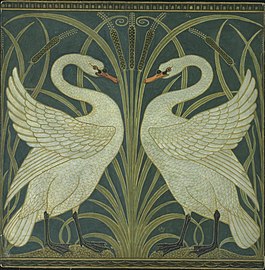






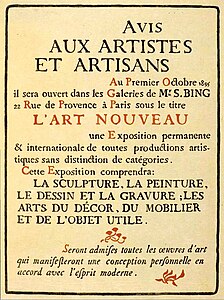







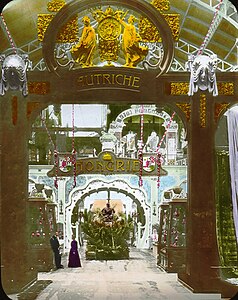
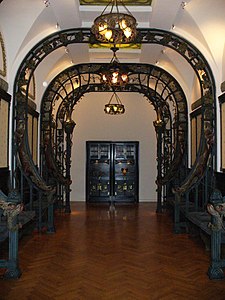


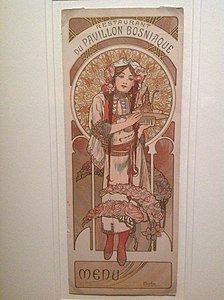


![Doorway of the Lavirotte Building, with ceramic sculptures by Jean-Baptiste Larrivé [fr]](http://upload.wikimedia.org/wikipedia/commons/thumb/4/47/XDSC_7288-29-av-Rapp-paris-7.jpg/176px-XDSC_7288-29-av-Rapp-paris-7.jpg)
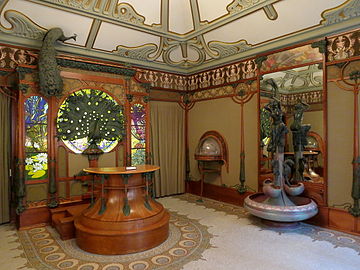



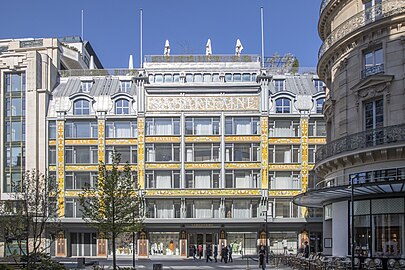
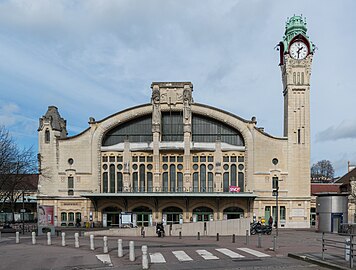








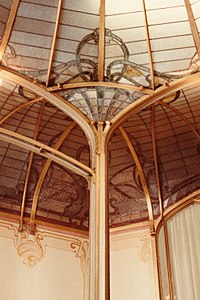




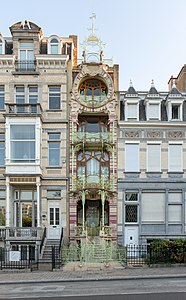

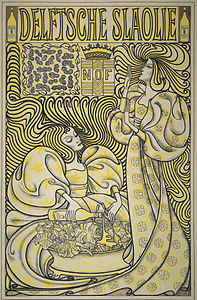





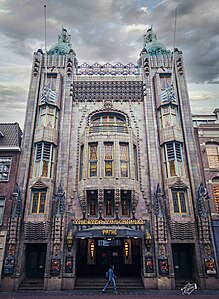




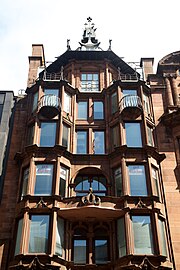

![The May Queen by Margaret Macdonald Mackintosh (1900)[66]](http://upload.wikimedia.org/wikipedia/commons/thumb/a/a8/The_May_Queen%2C_by_Margaret_Macdonald_Mackintosh%2C_1900%2C_pencil%2C_watercolour%2C_and_bodycolour%2C_heightened_with_silver%2C_on_oiled_tracing_paper%2C_33_x_69.2_cm%2C_private_collection.jpg/571px-thumbnail.jpg)
![Interior hallway view, Hill House, Helensburgh, Scotland, designed and built by Walter Blackie (1902–1904)[67]](http://upload.wikimedia.org/wikipedia/commons/thumb/4/4e/Hill_House_7_%2837376578142%29.jpg/317px-Hill_House_7_%2837376578142%29.jpg)
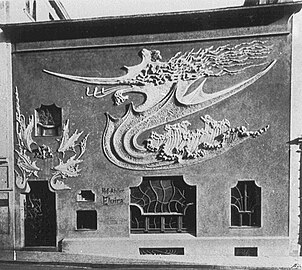





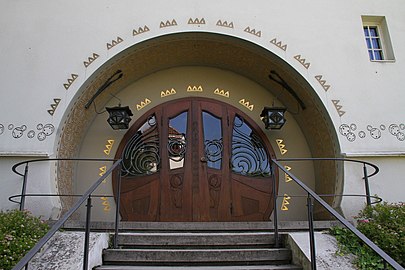


















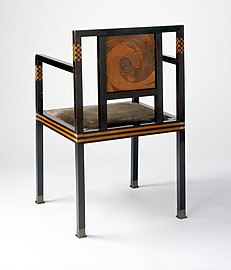
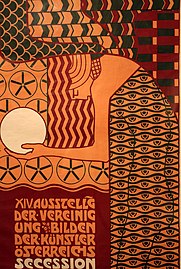
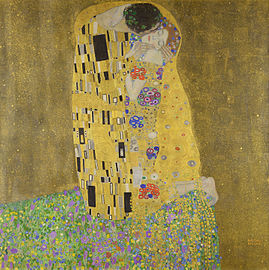
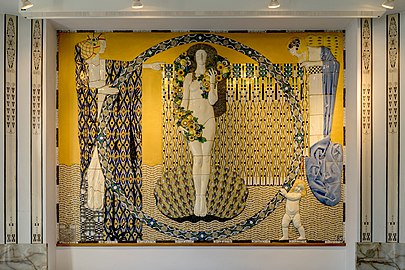
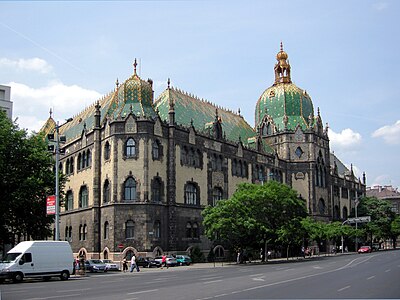


![Mosaic on the façade of Török Bank [fr] building in Budapest by Miksa Róth (1906)](http://upload.wikimedia.org/wikipedia/commons/thumb/2/20/T%C3%B6r%C3%B6k_bankhaz_03.JPG/400px-T%C3%B6r%C3%B6k_bankhaz_03.JPG)


![Brück House in Timișoara, today in Romania (1911). Along with Oradea, Timișoara is part of the Art Nouveau European Route[91]](http://upload.wikimedia.org/wikipedia/commons/thumb/f/f5/Timisoara%2C_Casa_Br%C3%BCck.jpg/240px-Timisoara%2C_Casa_Br%C3%BCck.jpg)











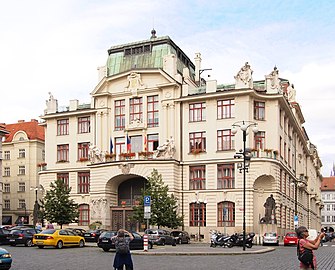





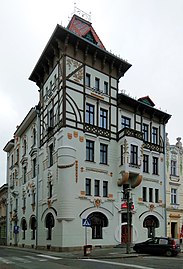

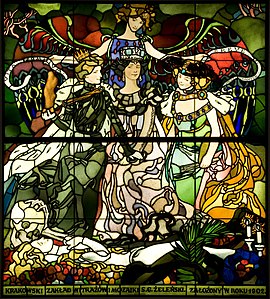


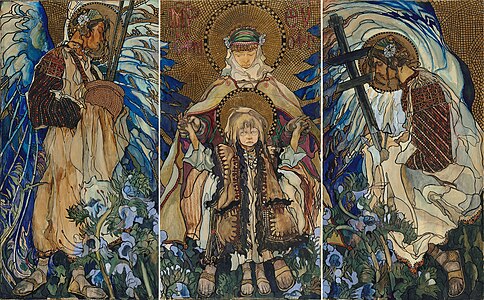











![Romulus Porescu House (Strada Doctor Paleologu no. 12) in Bucharest by Dimitrie Maimarolu (1905)[100]](http://upload.wikimedia.org/wikipedia/commons/thumb/a/a9/Old_photo_of_the_Romulus_Porescu_House_in_Bucharest_%2801%29.jpg/449px-Old_photo_of_the_Romulus_Porescu_House_in_Bucharest_%2801%29.jpg)

![Former Al. Assan shop (Strada Lipscani no. 72–74) in Bucharest, unknown architect (before 1906)[101]](http://upload.wikimedia.org/wikipedia/commons/thumb/1/11/72-74_Strada_Lipscani%2C_Bucharest_%2801%29.jpg/214px-72-74_Strada_Lipscani%2C_Bucharest_%2801%29.jpg)
![Mița the Cyclist House in Bucharest by Nicolae C. Mihăescu (1908), mix of Beaux Arts and Art Nouveau[102]](http://upload.wikimedia.org/wikipedia/commons/thumb/4/41/9_Strada_Biserica_Amzei%2C_Bucharest_%2801%29.jpg/268px-9_Strada_Biserica_Amzei%2C_Bucharest_%2801%29.jpg)




![Stove in the Mița the Cyclist House (Strada Biserica Amzei no. 9), Bucharest, possibly designed by Nicolae C. Mihăescu (1908)[102]](http://upload.wikimedia.org/wikipedia/commons/thumb/2/2c/Art_Nouveau_polychrome_tiled_stove_in_the_Mi%C8%9Ba_the_Cyclist_House%2C_Bucharest_%2804%29.jpg/388px-Art_Nouveau_polychrome_tiled_stove_in_the_Mi%C8%9Ba_the_Cyclist_House%2C_Bucharest_%2804%29.jpg)





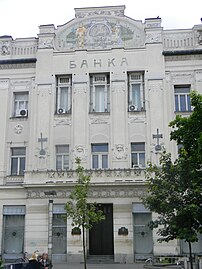



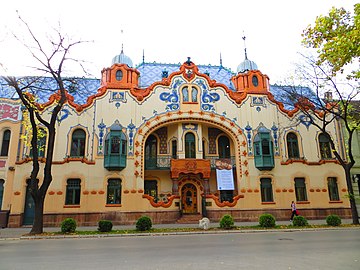











![Casa Milà in Barcelona by Gaudí (1906–1912)[115]](http://upload.wikimedia.org/wikipedia/commons/thumb/d/de/Casa_Mil%C3%A0%2C_general_view.jpg/347px-Casa_Mil%C3%A0%2C_general_view.jpg)
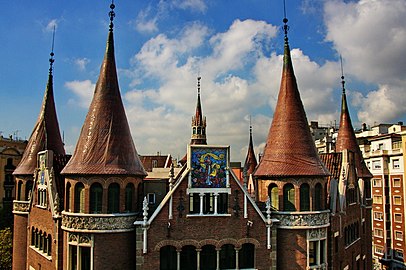
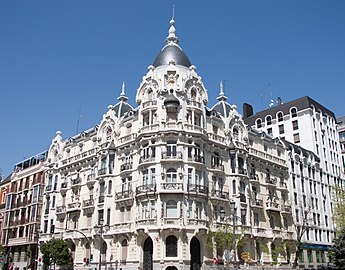
![Sanctuary of Maria Magdalena [ca] in Novelda, Valencian Community (1918–1946)](http://upload.wikimedia.org/wikipedia/commons/thumb/2/28/Santuario_Novelda.jpg/202px-Santuario_Novelda.jpg)

![Sculpture of polychrome terracota by Lambert Escaler [ca] (1902)](http://upload.wikimedia.org/wikipedia/commons/thumb/c/c1/El_Pet%C3%B3_Perdut._Lambert_Escaler_i_Mil%C3%A0.JPG/180px-El_Pet%C3%B3_Perdut._Lambert_Escaler_i_Mil%C3%A0.JPG)
![Furniture by Gaspar Homar [ca] (1903)](http://upload.wikimedia.org/wikipedia/commons/thumb/b/b6/140_La_sardana%2C_plaf%C3%B3_de_marqueteria_de_Gaspar_Homar.jpg/360px-140_La_sardana%2C_plaf%C3%B3_de_marqueteria_de_Gaspar_Homar.jpg)





![Façade of Major Pessoa Residence in Aveiro (1907–1909)[123]](http://upload.wikimedia.org/wikipedia/commons/thumb/4/4e/Aveiro_Casa_do_Major_Pessoa_856.jpg/200px-Aveiro_Casa_do_Major_Pessoa_856.jpg)

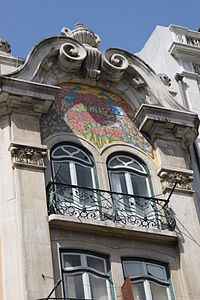








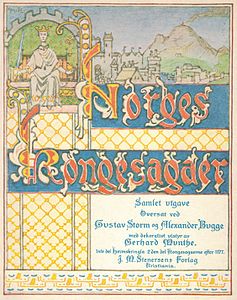








![An Art Nouveau Fabergé egg[nb 3] (1898)](http://upload.wikimedia.org/wikipedia/commons/thumb/2/22/Faberg%C3%A9_egg_Rome_03.JPG/141px-Faberg%C3%A9_egg_Rome_03.JPG)






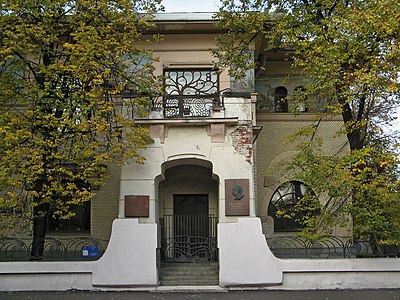










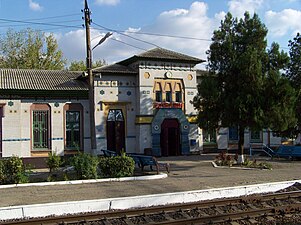













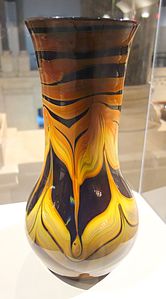





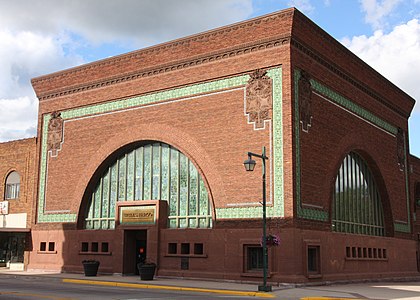






![Metal work, ceramics and statues at the façade of Club Español building [es] in Rosario (1912)](http://upload.wikimedia.org/wikipedia/commons/thumb/8/86/Club_Espa%C3%B1ol_Rosario_2.jpg/400px-Club_Espa%C3%B1ol_Rosario_2.jpg)





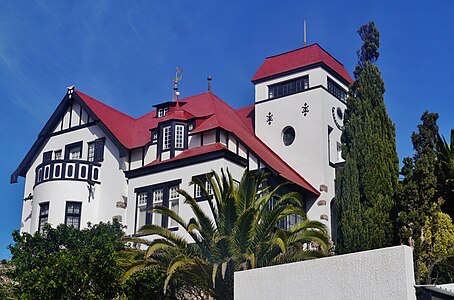
![Mexico City Gran Hotel interior, built in 1918 by Jacques Grüber[157][158]](http://upload.wikimedia.org/wikipedia/commons/thumb/a/a8/Gran_Vitral_Tiffany_del_Hotel_Ciudad_de_Mexico_-_panoramio.jpg/451px-Gran_Vitral_Tiffany_del_Hotel_Ciudad_de_Mexico_-_panoramio.jpg)


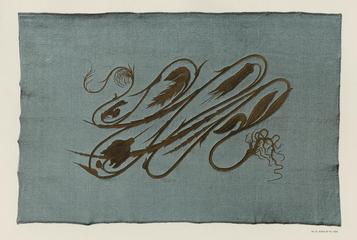



![Decorative stylized lettering – Grave of the Caillat Family in Père Lachaise Cemetery, Paris, by Guimard (1899)[169]](http://upload.wikimedia.org/wikipedia/commons/thumb/d/d7/P%C3%A8re-Lachaise_-_Division_2_-_Ernest_Caillat_01_%28cropped%29.jpg/172px-P%C3%A8re-Lachaise_-_Division_2_-_Ernest_Caillat_01_%28cropped%29.jpg)


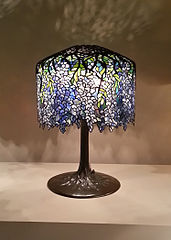




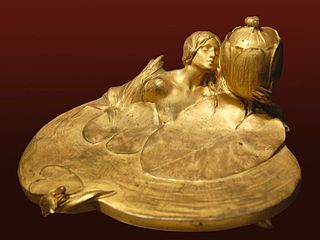




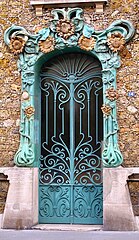
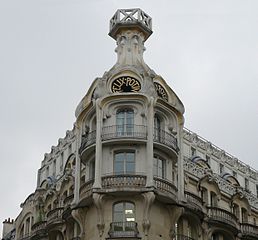




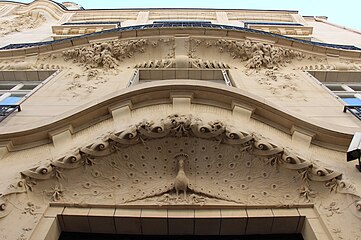
![Nymphs – Relief on the Fanny and Isac Popper House (Strada Sfinților no. 1), Bucharest, by Alfred Popper (1914)[170]](http://upload.wikimedia.org/wikipedia/commons/thumb/f/f5/1_Strada_Sfin%C8%9Bilor%2C_Bucharest_%2803%29.jpg/181px-1_Strada_Sfin%C8%9Bilor%2C_Bucharest_%2803%29.jpg)

![Mix of Art Nouveau and Gothic Revival – Rue Gustave-Lemaire no. 51 in Dunkerque, France, with pointed arched-dormer windows and balcony loggia, unknown architect, decorated with sculptures by Maurice Ringot (1903–1910)[175]](http://upload.wikimedia.org/wikipedia/commons/thumb/b/b4/51_rue_Gustave_Lemaire.jpg/225px-51_rue_Gustave_Lemaire.jpg)
![Mix of Art Nouveau and Egyptian Revival – Round corner window of the Romulus Porescu House (Strada Doctor Paleologu no. 12) in Bucharest, decorated with lotus flowers, a motif used frequently in Ancient Egyptian art, designed by Dimitrie Maimarolu (1905)[176]](http://upload.wikimedia.org/wikipedia/commons/thumb/8/8e/Negustori_col%C8%9B_cu_Paleologu._-streetphotography_-bucharest_-windows_-rusty_-old_%2834264373636%29.jpg/300px-Negustori_col%C8%9B_cu_Paleologu._-streetphotography_-bucharest_-windows_-rusty_-old_%2834264373636%29.jpg)



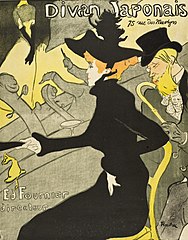






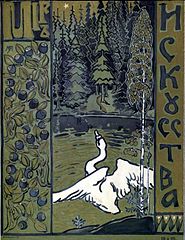







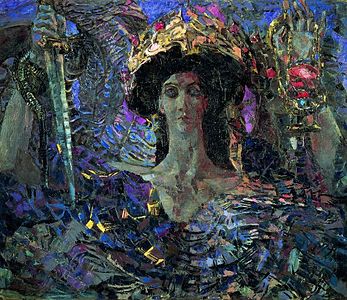


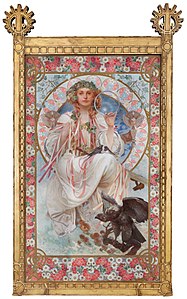








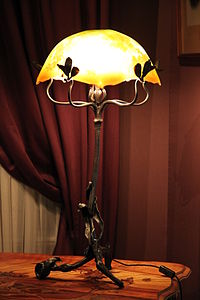





![Jack-in-the-pulpit vase by Tiffany (c. 1913)[190]](http://upload.wikimedia.org/wikipedia/commons/thumb/6/65/Ngv%2C_louis_comfort_tiffany%2C_jack-in-the-pulpit_vase%2C_1913_circa_01.JPG/205px-Ngv%2C_louis_comfort_tiffany%2C_jack-in-the-pulpit_vase%2C_1913_circa_01.JPG)

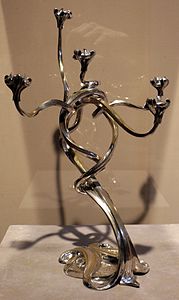






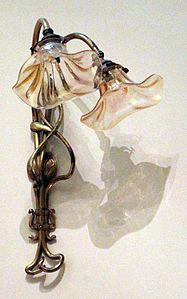












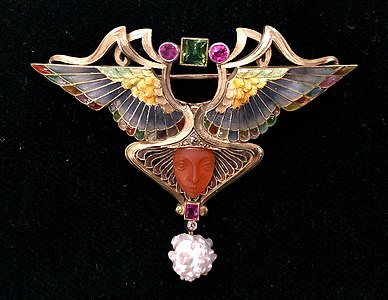

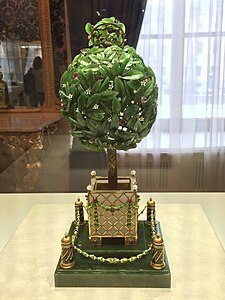
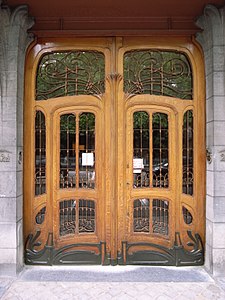






![Relief on the façade of the Fanny and Isac Popper House (Strada Sfinților no. 1) in Bucharest, designed by Alfred Popper (1914)[170]](http://upload.wikimedia.org/wikipedia/commons/thumb/b/b3/Art_Nouveau_relief_on_Strada_Sfin%C8%9Bilor_from_Bucharest_%28Romania%29.jpg/274px-Art_Nouveau_relief_on_Strada_Sfin%C8%9Bilor_from_Bucharest_%28Romania%29.jpg)






![Bust decorating the balconies of 29 avenue Rapp, Paris, by Alexandre Bigot and Jean-Baptiste Larrivé [fr] (1901)](http://upload.wikimedia.org/wikipedia/commons/thumb/1/19/Bigot_-_Lavirotte_-_Larriv%C3%A9_-_Bust%2C_attic_element_with_green-glaze.jpg/177px-Bigot_-_Lavirotte_-_Larriv%C3%A9_-_Bust%2C_attic_element_with_green-glaze.jpg)











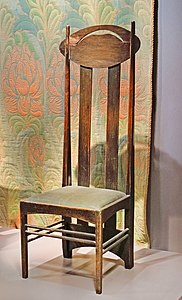



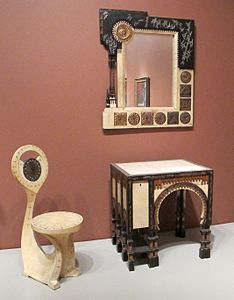

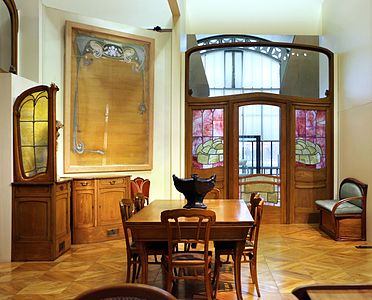
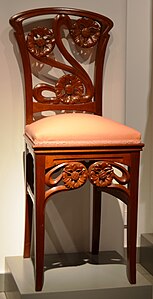


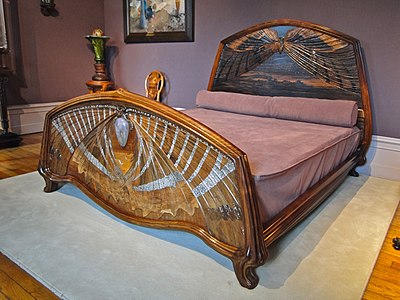
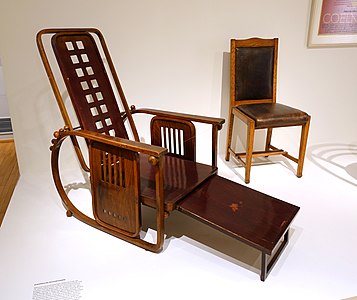



![Hand-painted tile panel on the façade of the Grande Maison de Blanc in Brussels, designed by Privat Livemont and made by the Boch Frères Kéramis (1897–98)[216]](http://upload.wikimedia.org/wikipedia/commons/thumb/3/3b/Grande_Maison_de_Blanc_Femme_2.JPG/209px-Grande_Maison_de_Blanc_Femme_2.JPG)
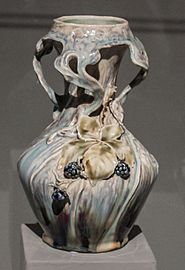




![Tiles in the hallway of Allée de la Robertsau no. 56 in Strasbourg, France, designed by Frantz Lütke and Heinrich Backes (1902)[217]](http://upload.wikimedia.org/wikipedia/commons/thumb/2/29/Immeuble_au_56_all%C3%A9e_de_la_Robertsau_%C3%A0_Strasbourg.jpg/202px-Immeuble_au_56_all%C3%A9e_de_la_Robertsau_%C3%A0_Strasbourg.jpg)




![Facade of Avenue Charles-de-Gaulle no. 43, Nevers, France, by Georges-Théodore Renaud (architect) and Alexandre Bigot (ceramist) (1905)[218]](http://upload.wikimedia.org/wikipedia/commons/thumb/9/97/Magasin_43_Avenue_G%C3%A9n%C3%A9ral_Gaulle_-_Nevers_%28FR58%29_-_2023-09-21_-_1.jpg/229px-Magasin_43_Avenue_G%C3%A9n%C3%A9ral_Gaulle_-_Nevers_%28FR58%29_-_2023-09-21_-_1.jpg)
![Polychrome tiled stove in the Mița the Cyclist House (Strada Biserica Amzei no. 9) in Bucharest, by Nicolae C. Mihăescu (1908)[219]](http://upload.wikimedia.org/wikipedia/commons/thumb/8/84/Art_Nouveau_polychrome_tiled_stove_in_the_Mi%C8%9Ba_the_Cyclist_House%2C_Bucharest_%2801%29.jpg/126px-Art_Nouveau_polychrome_tiled_stove_in_the_Mi%C8%9Ba_the_Cyclist_House%2C_Bucharest_%2801%29.jpg)


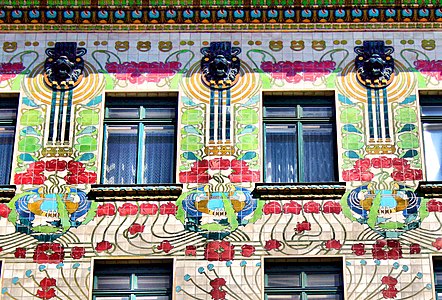
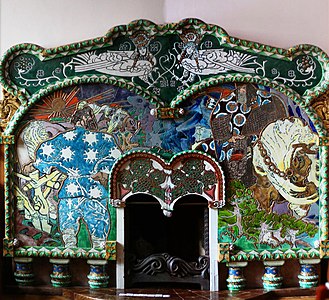

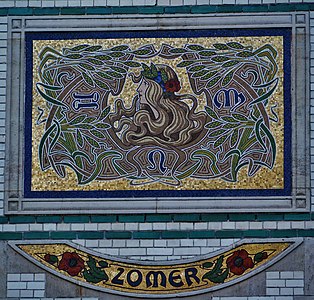
![Mosaics designed by Oskar Graf for Merkel’sches Schwimmbad [de] in Esslingen am Neckar, Germany (1905–1907)](http://upload.wikimedia.org/wikipedia/commons/thumb/4/44/Esslingen_a.N._-_Altstadt_-_Merkelsches_Schwimmbad_-_Fassadenmosaik.jpg/400px-Esslingen_a.N._-_Altstadt_-_Merkelsches_Schwimmbad_-_Fassadenmosaik.jpg)
![Mandylion by Nicholas Roerich in Talashkino, Russia (1908–1914)[223]](http://upload.wikimedia.org/wikipedia/commons/thumb/4/4f/Church_of_the_Holy_Spirit_02.jpg/400px-Church_of_the_Holy_Spirit_02.jpg)

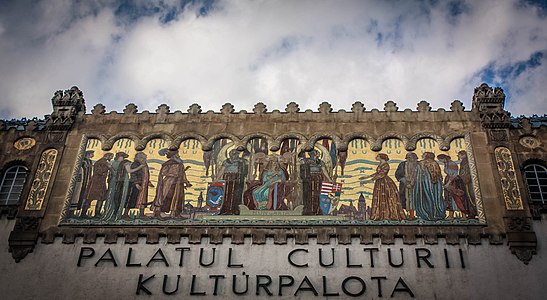





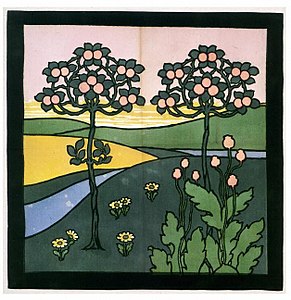

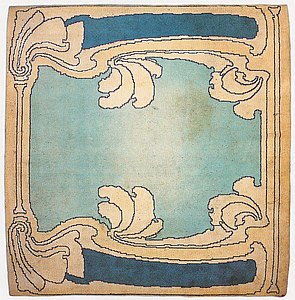
![Entry for the House for an art lover competition, by Charles Rennie Mackintosh (1900)[229]](http://upload.wikimedia.org/wikipedia/commons/thumb/1/15/Mackintosh%2C_House_for_an_Art_Lover%2C_competition_entry.jpg/342px-Mackintosh%2C_House_for_an_Art_Lover%2C_competition_entry.jpg)
![Secessionist exterior of the Bazil Assan House (Strada Scaune no. 21–23, currently Strada Tudor Arghezi) in Bucharest, by Marcel Kammerer (1902–1911), demolished in the late 1950s or the 1960s to make space for the National Theatre Bucharest[230]](http://upload.wikimedia.org/wikipedia/commons/thumb/a/ad/Main_view_of_the_Bazil_Assan_House_in_Bucharest.jpg/353px-Main_view_of_the_Bazil_Assan_House_in_Bucharest.jpg)
![Secessionist façade of the Stoclet Palace in Brussels, by Josef Hoffmann (1905–1911)[231]](http://upload.wikimedia.org/wikipedia/commons/thumb/0/0b/Bruxelles_-_Palais_Stoclet_%283%29_%28cropped_center%29.jpg/156px-Bruxelles_-_Palais_Stoclet_%283%29_%28cropped_center%29.jpg)
![Secessionist putto with two cornucopias with floral cascades, very similar to the ones found in a lot of Art Deco of the 1910s and 1920s, by Michael Powolny, designed in c. 1907, produced in 1912, ceramic, Kunstgewerbemuseum Berlin[232]](http://upload.wikimedia.org/wikipedia/commons/thumb/0/08/Michael_powolny_e_bertold_l%C3%B6ffler%2C_putto_con_cornucopia%2C_vienna_1912_ca.jpg/209px-Michael_powolny_e_bertold_l%C3%B6ffler%2C_putto_con_cornucopia%2C_vienna_1912_ca.jpg)

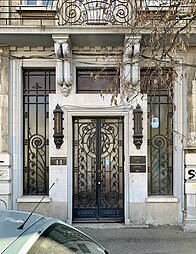



![Sinuous curves on the façade of Avenue Montaigne no. 26 in Paris, by Louis Duhayon and Marcel Julien (1937)[233]](http://upload.wikimedia.org/wikipedia/commons/thumb/5/57/Avenue_Montaigne_%2847128639262%29.jpg/383px-Avenue_Montaigne_%2847128639262%29.jpg)

![Kalandestraat no. 1 in Ghent, Belgium, by Denis Van Impe and Colette Van Vynckt (1980)[235]](http://upload.wikimedia.org/wikipedia/commons/thumb/5/54/Touch%C3%A9_Gent_%2832840632118%29.jpg/180px-Touch%C3%A9_Gent_%2832840632118%29.jpg)

